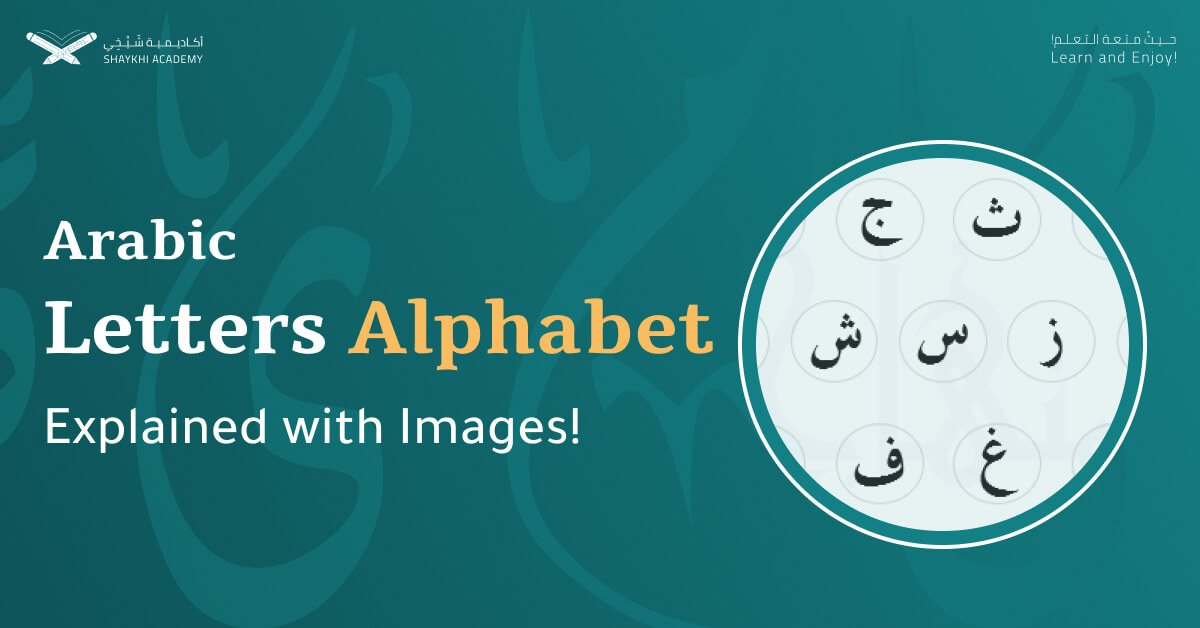The Arabic alphabet consists of 28 letters, each with unique pronunciation and characteristics. From “Alif” to “Yaa,” each letter is distinct, requiring specific mouth movements and vocalizations. Some letters, like “Baa” and “Taa,” have English equivalents, while others, like “Thaa” and “Gheen,” demand different articulations.
Additionally, complex letters such as “Haa,” “Ein,” and “Qaaf” present pronunciation challenges. Phonetics play a vital role in understanding Arabic sounds, categorized into silent sounds and consonant sounds. Learning proper pronunciation is essential, facilitated by resources like online classes.
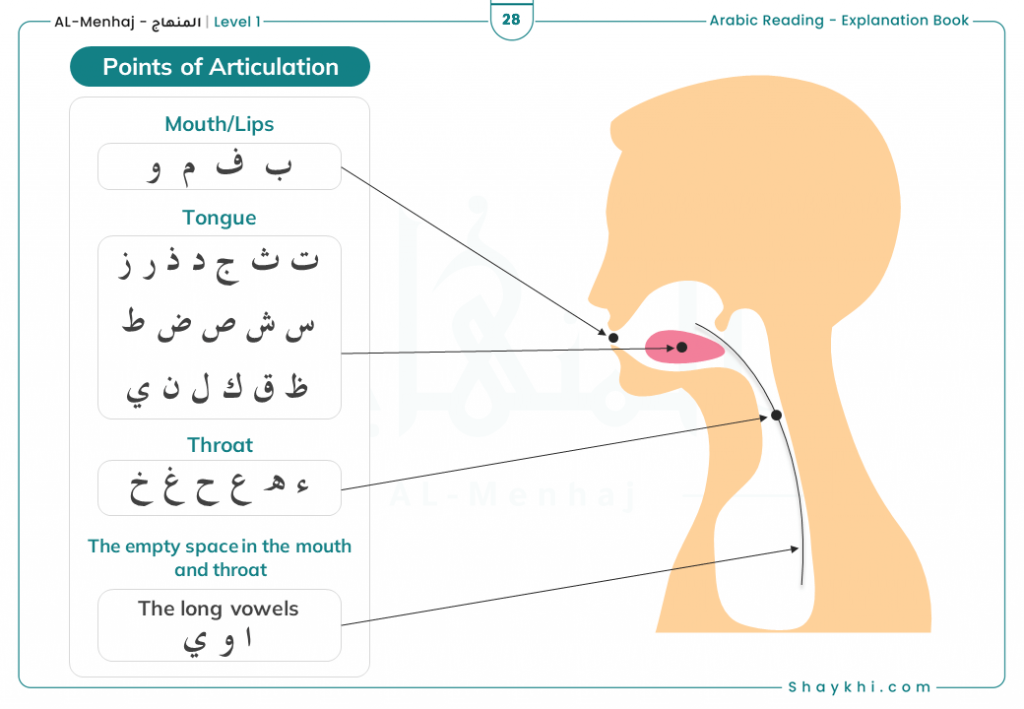
If you want to learn the pronunciation and sounds of Arabic Letters Alphabet, its points of articulation, and their charts and tables, this article is for you!
In this article, we’ll discuss the pronunciation of all sounds of Arabic letters in order, one by one! Are you ready?! Let’s start!
How to pronounce Arabic Letters?
Pronouncing Arabic letters requires understanding their points of articulation, known as Makhaarij. Each letter in Arabic has a specific origin in the mouth or throat, influencing how it is pronounced. For example, Alif (ا) is a vowel that lengthens the sound of the letter before it, while Bā’ (ب) is pronounced by pressing the lips together.
The articulation varies for other letters like Thā’ (ث), which involves placing the tongue between the upper and lower teeth, or Ḥā’ (ح), which is produced from the middle of the throat. Mastery of these articulations is essential for accurate Quranic recitation and understanding Tajweed rules.
The distinction between heavy and light letters also plays a crucial role. Heavy letters, like Ṣād (ص) and Ṭā’ (ط), require raising the back of the tongue to create a deep sound, while light letters, such as Sīn (س) and Tā’ (ت), maintain a neutral tongue position.
Let’s discuss them in details below:
Choose any Letter to move to it directly! 🚀
What is the Purpose of Learning the Makhaarij of The Arabic Language?
Learning the Makhaarij of The Arabic Language is the first step to make the reciter proficient in reciting the Qur’an by observing the correct pronunciation of every letter, without any exaggeration or deficiency, so that the reciter can read the Quran, after also learning Tajweed, properly as it was revealed to the prophet Muhammed, peace be upon him.
This post will also discuss some issues about Quran Alphabet!
Letter Alif Pronunciation
Letter Alif is the 1st letter of Arabic Letters Alphabet Arabic and this’s its shape:
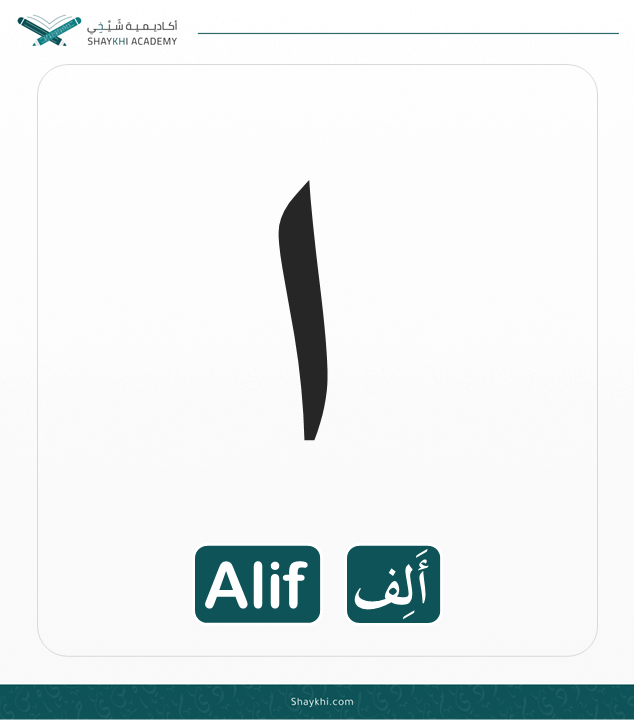
To pronounce the letter Alif (أ) you should open your mouth wide and feel the vibration down your throat.
Its pronunciation is equivalent to the letter “A” in the English.
The Point of Articulation of the Letter Alif (ألف) is the empty space in the mouth and throat and this letter doesn’t have its own sound, but it’s just used to lengthen the time of the sound of the Maftouh letter before (Mad letter) as it will be discussed in detail in Mad Alif (المد بالألف) lesson.
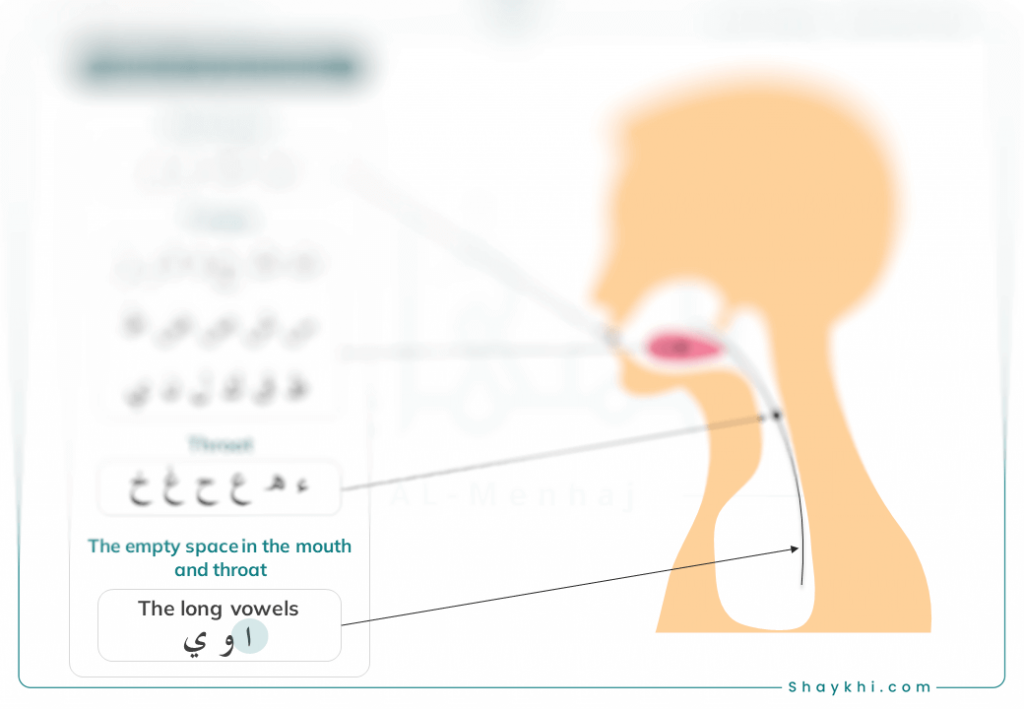
Note: Also, all the remaining Mad letters have the same point of articulation, which are Mad Yā’ and Mad Wāw.
Is Alif Heavy Letter or Light Letter?
Alif is heavy in some cases and light in others depending on the letter before, as if the letter before is light, it will be light, while if the letter before is heavy it will be heavy. Thus, the letter before determines whether Alif is heavy or light!
What is the Counterpart of Letter Alif (ألف) in English?
The sound of the letter (A) as in the word cat.
Is There a Common Mistake When Pronounce Letter Alif (ألف)?
What Is The Transliteration Letter Alif (ألف)?
The transliteration of Letter ألف is Alif (our Transliterating Arabic Characters is based on IJMES Transliteration Chart).
Read more about: Types Of Alif In Arabic – Alif Words, Forms, And Examples
Letter Bā’ Pronunciation
Letter Bā’ is the 2nd letter of Arabic Letters Alphabet Arabic and this’s its shape:
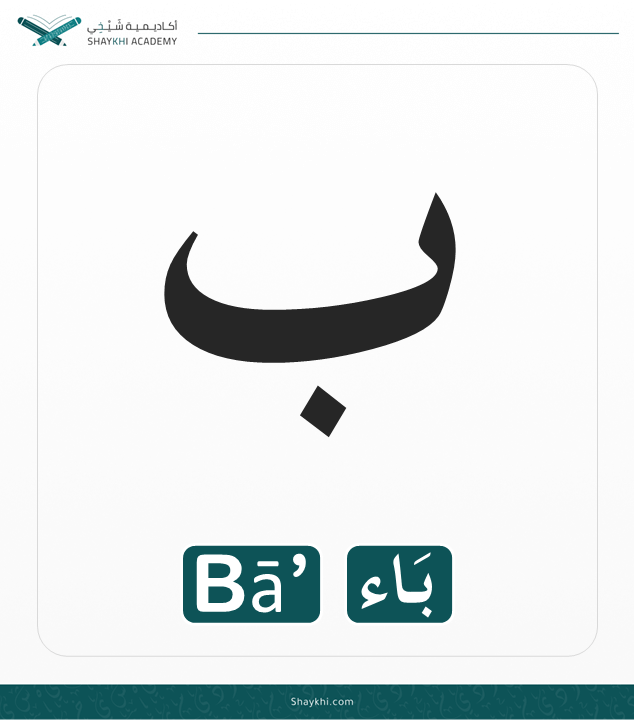
The Point of Articulation of the Letter Bā’ (بَـــاء) is the lips as it’s pronounced by closing or pressing the two lips together.
To pronounce the letter baa (ب) you should Close your lips and blasting the sound through them.
Its pronunciation is equivalent to the letter “B” in the English.
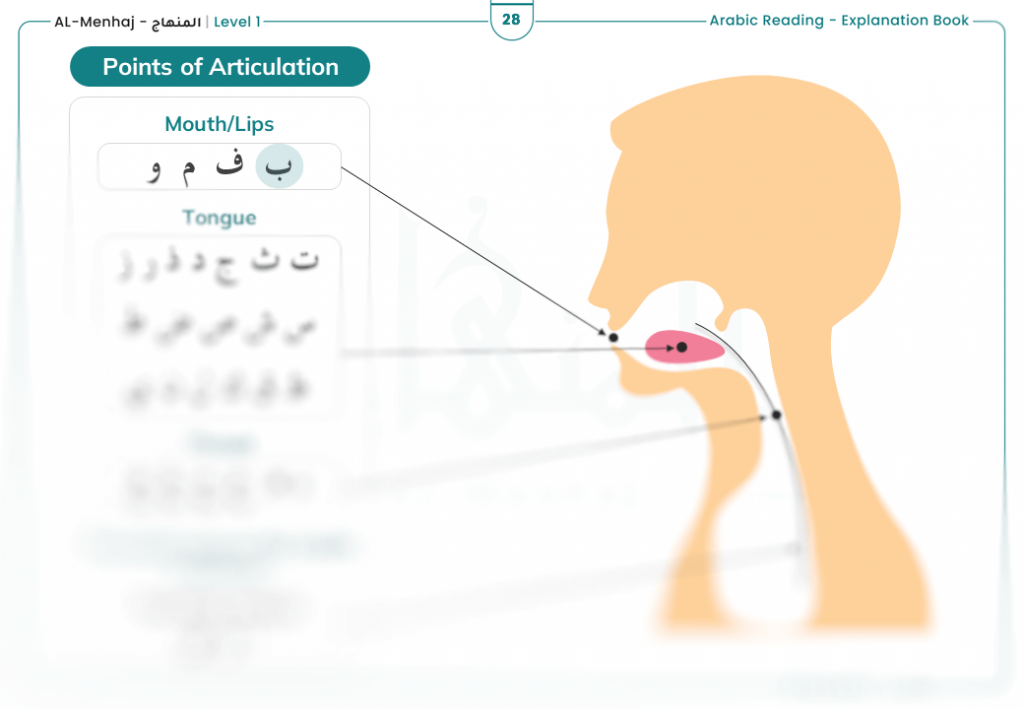
Letter Tā’ Pronunciation
Letter Tā’ is the 3rd letter of Arabic Letters Alphabet Arabic and this’s its shape:
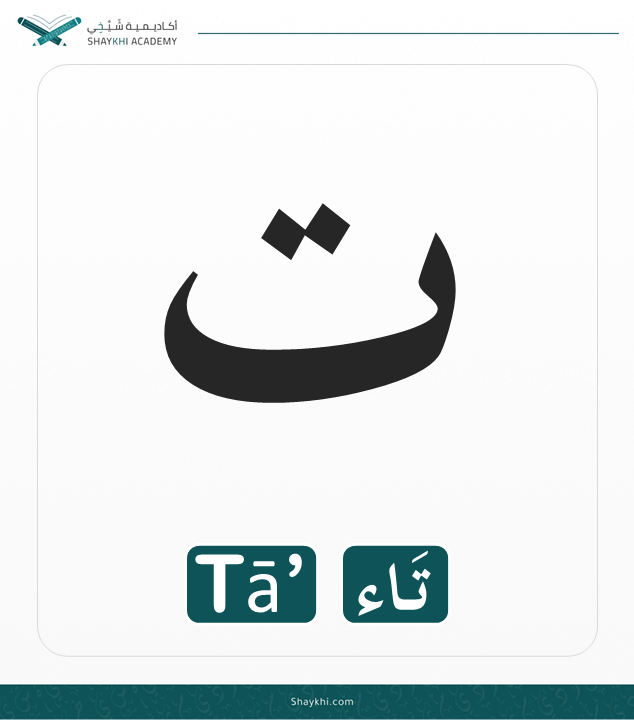
The Point of Articulation of the Letter Tā’ (تَـــاء) is the tongue as the top side of the tip of the tongue touches the gums of the front two upper incisors.
To pronounce the letter Taa (ت) you should Place the tongue on the upper teeth.
Its pronunciation is equivalent to the letter “T” in the English.
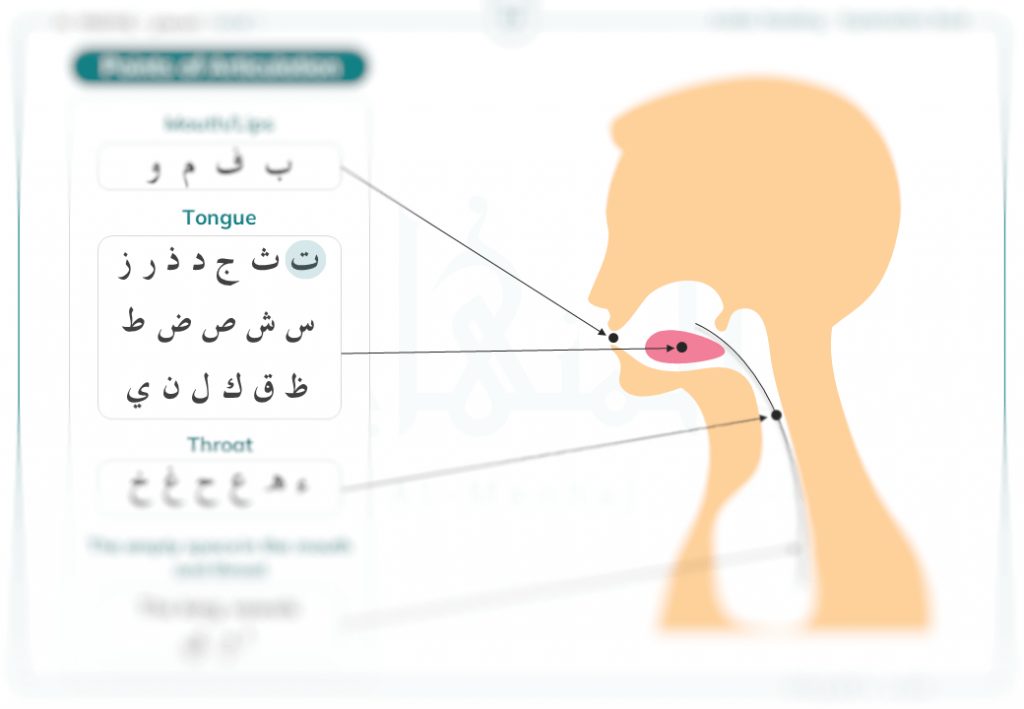
Letter Thā’ Pronunciation
Letter Thā’ is the 4th letter of Arabic Letters Alphabet Arabic and this’s its shape:
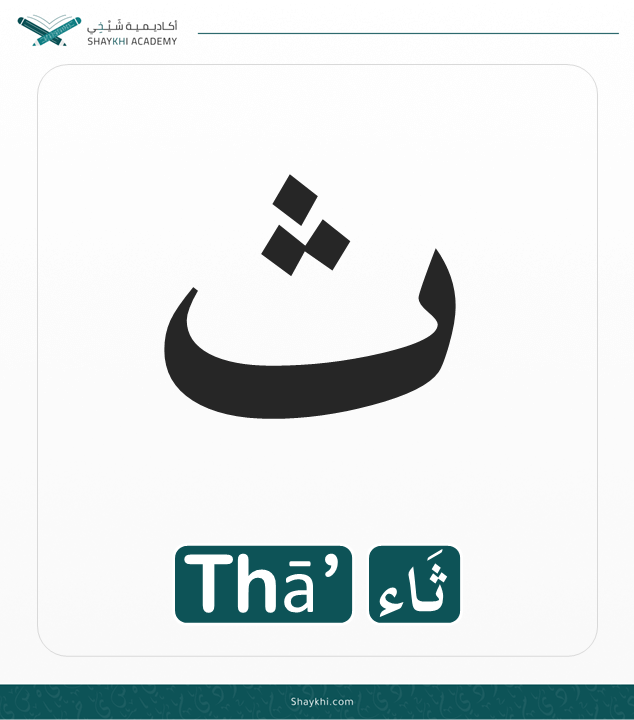
The Point of Articulation of the Letter Thā’ (ثَـــاء) is the tongue as the tip of the tongue touches the bottom edge of the front two upper incisors.
To pronounce the letter Thaa (ث) is done by placing the tongue between the upper and lower teeth and making the sound.
This letter does not have a corresponding letter in the English language, but its sound is similar to the sound resulting from the combination of the letters t with h
“th”.
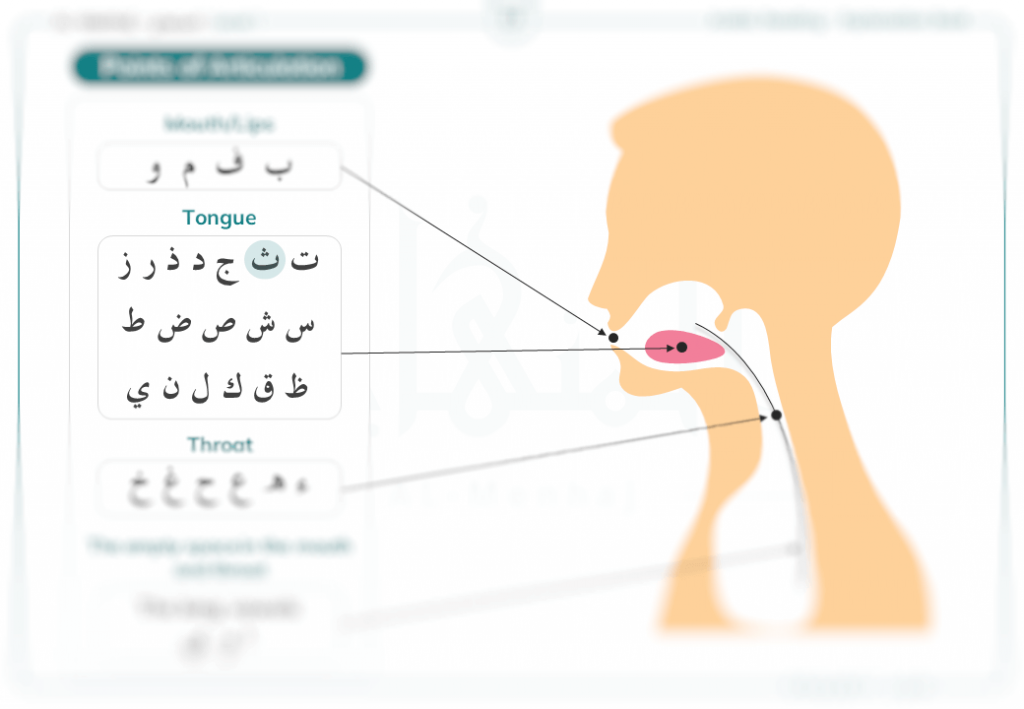
Common mistake: pronouncing the Letter Thā’ (ثَـــاء) as letter Sīn (سِيـن). An example: فكثركم.
Letter Jīm Pronunciation
Letter Jīm is the 5th letter of Arabic Letters Alphabet Arabic and this’s its shape:

The Point of Articulation of the Letter Jīm (جِـيـم) is the tongue as the middle of the tongue touches what lies opposite, which is the roof of the mouth.
The “jeem” is pronounced by using the tongue on the back of the upper teeth and making the sound.
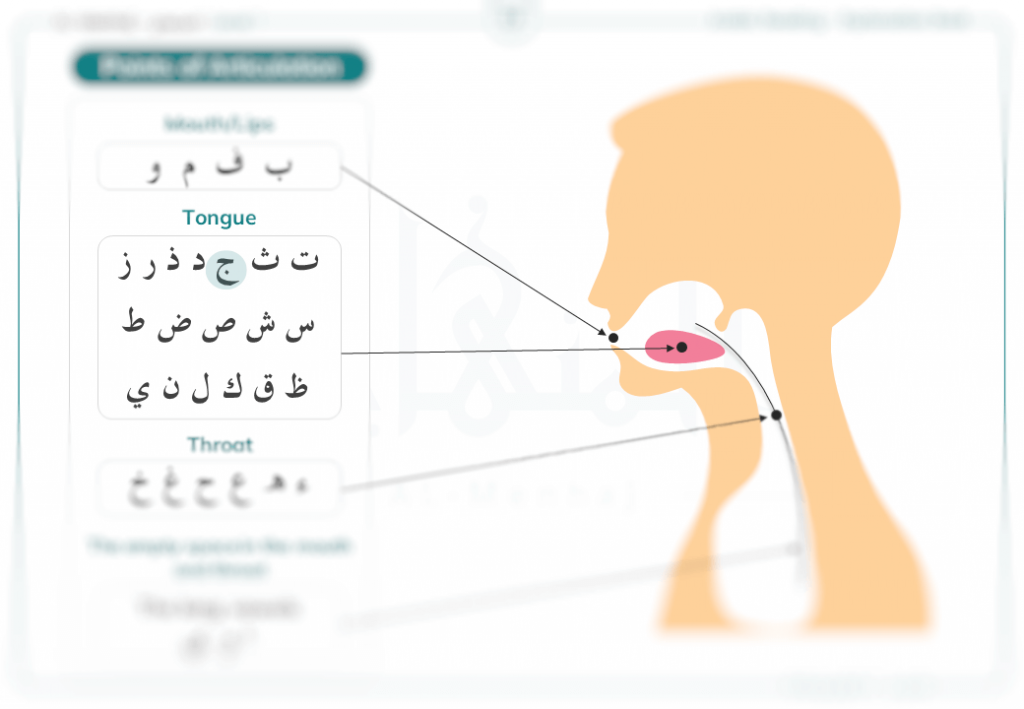
Common mistake: pronouncing the letter Jīm (جِـيـم) as the letter “G” in English. An example: الحج
Letter Ḥā’ Pronunciation
Letter Ḥā’ is the 6th letter of Arabic Letters Alphabet Arabic and this’s its shape:
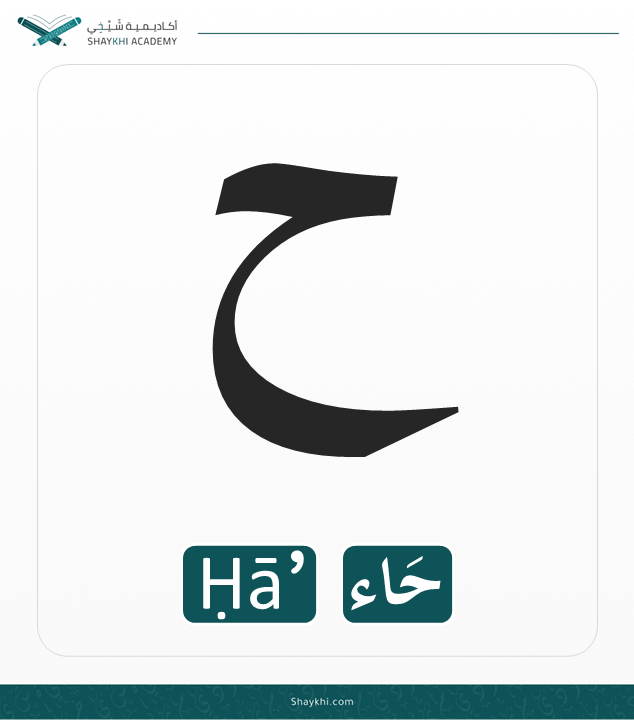
The Point of Articulation of the Letter Ḥā’ (حَـاء) is the throat as it’s pronounced from the middle part of the throat which lies halfway between the beginning and the end of the throat.
“Haa” is the sound you make when you clear your throat, only keep your mouth open when you do. Usually, when we clear our throats, we start by holding in air then letting it out forcefully. With ح , you end the letter by suddenly cutting the air.
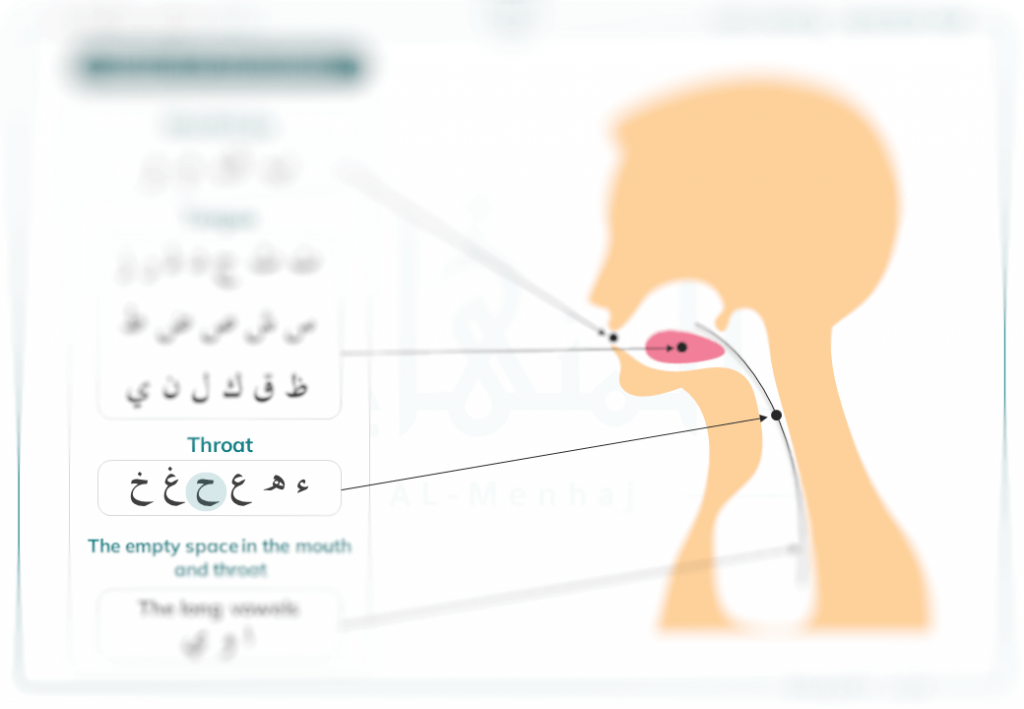
Common mistake: there is a common mistake among non-native Arabic speakers when they pronounce the letter Ḥā’ (حَـاء), which is pronouncing it similar to the letter H in English.
Imagination: to be able to pronounce this letter imagine that you’re breathing on glasses before cleaning them or imagine what you’ll do if you drink a cup of cold lemon on a hot day 🙂
Letter Khā’ Pronunciation
Letter Khā’ is the 7th letter of Arabic Letters Alphabet Arabic and this’s its shape:

The Point of Articulation of the Letter Khā’ (خَـاء) is the throat as it’s pronounced from the closest part of the throat which is the beginning of the throat, or the closest to the mouth.
Like forcing something out of the throat. The “khaa” requires less effort than you might imagine, and its ending is like the “Haa” when the air ends.
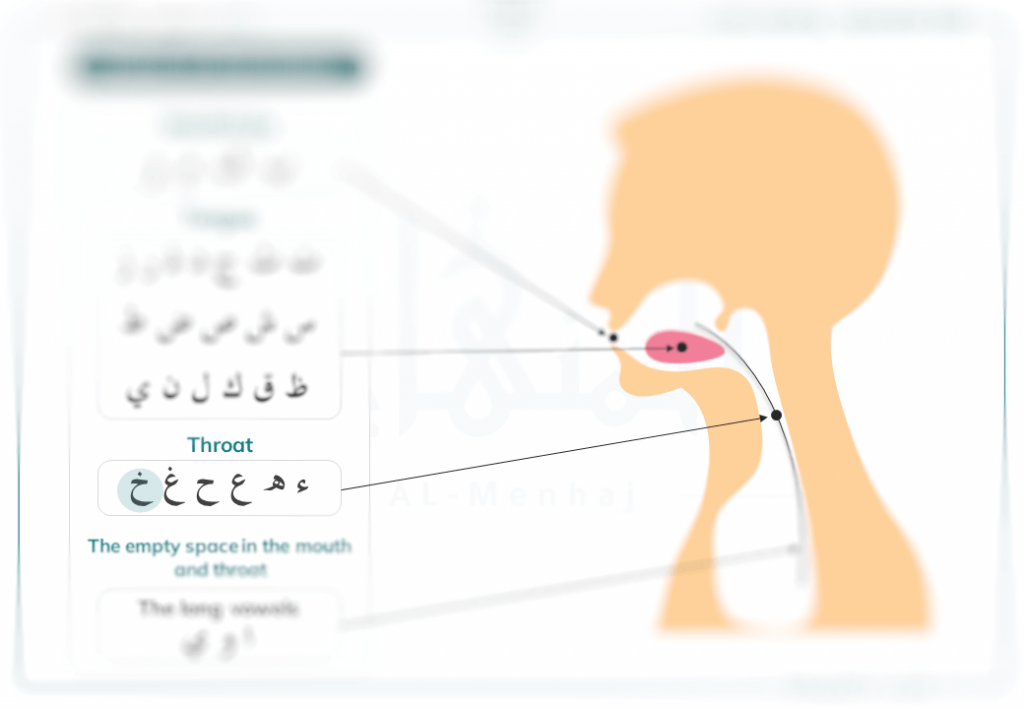
Letter Dāl Pronunciation
Letter Dāl is the 8th letter of Arabic Letters Alphabet Arabic and this’s its shape:
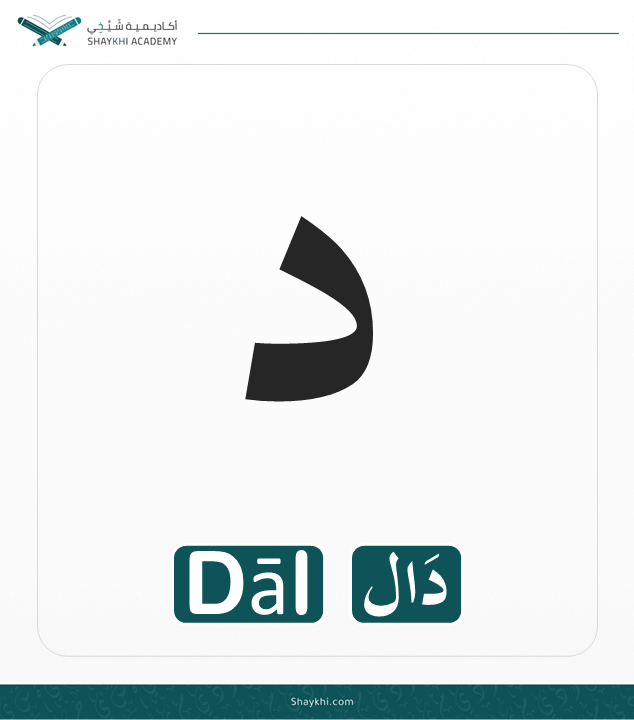
The Point of Articulation of the Letter Dāl (دَال) is the tongue as the top side of the tip of the tongue touches the gums of the front two upper incisors.
To pronounce the letter daal (د) you should produce sound from the mouth without using the throat.
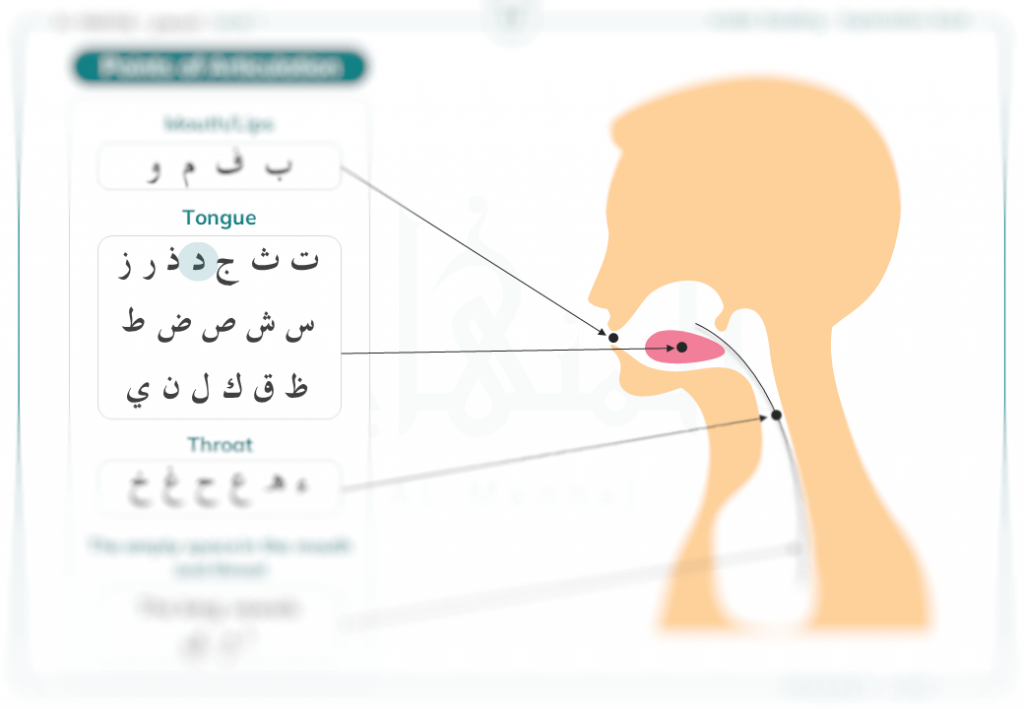
Common mistake: Making it heavy. An example: صُدُور.
Letter Dhāl Pronunciation
Letter Dhāl is the 9th letter of Arabic Letters Alphabet Arabic and this’s its shape:
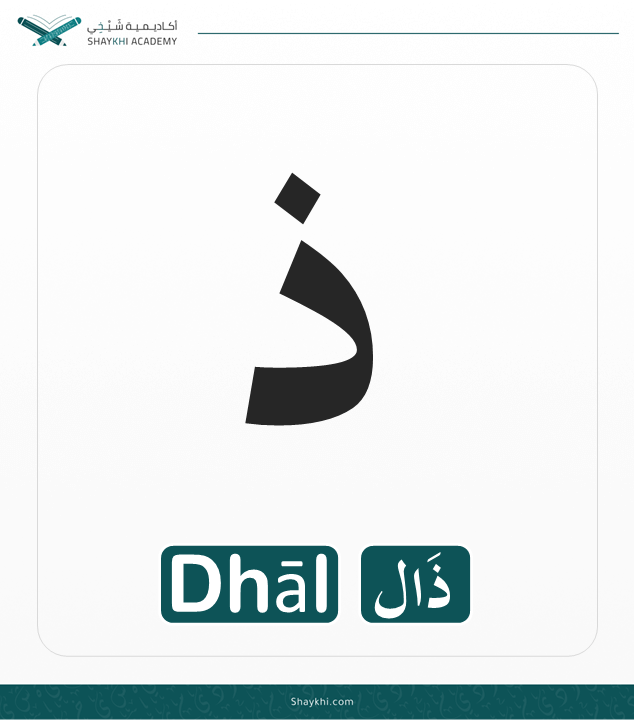
The Point of Articulation of the Letter Dhāl (ذَال) is the tongue as the tip of the tongue touches the bottom edge of the front two upper incisors.
The “zaal” is pronounced by placing the tongue on the front upper teeth and making the sound with a light touch.
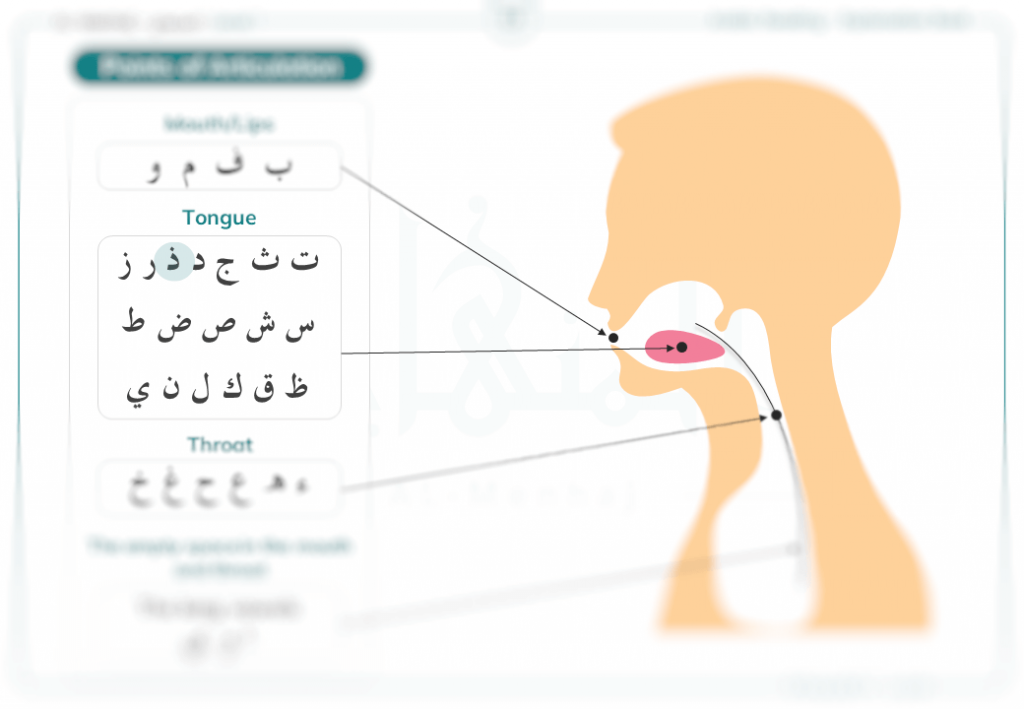
Common mistake: pronouncing the letter Dhāl (ذَال) as Letter Zāy (زَاي/زَيْ). An example: الذين.
Letter Rā’ Pronunciation
Letter Rā’ is the 10th letter of Arabic Letters Alphabet Arabic and this’s its shape:
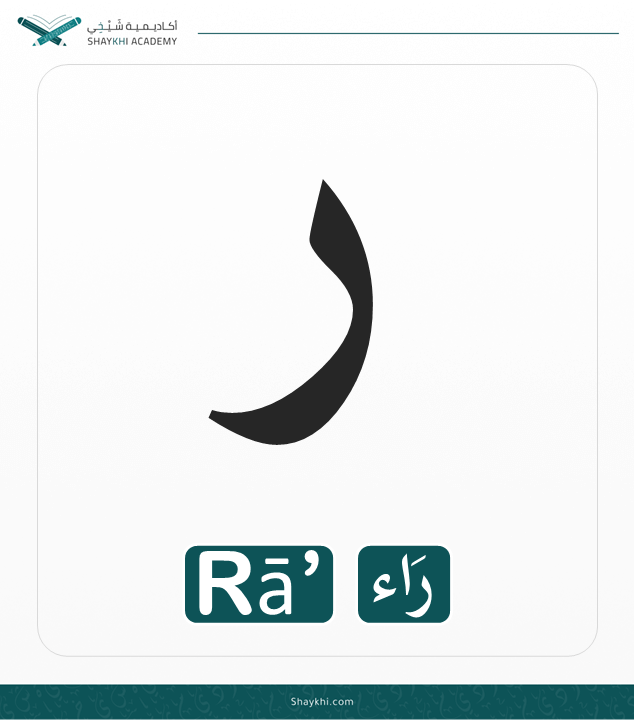
The Point of Articulation of the Letter Rā’ (رَاء) is the tongue as the tip of the tongue touches the hard palate close to the gums of the front two upper incisors.
In order to pronounce the letter “raa”, you should make the sound out of your mouth without using your throat.
Its pronunciation is equivalent to the letter “R” in the English.
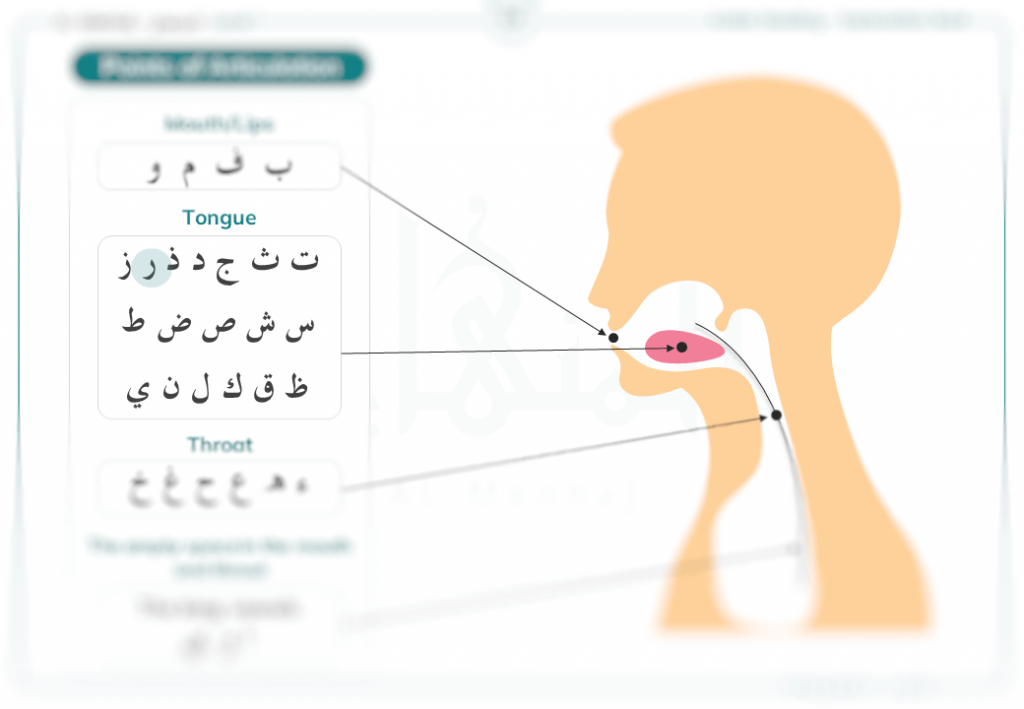
What is the difference between the letter Rā’ and the English letter “R”?
As we said, the Point of Articulation of the Letter Rā’ (رَاء) is the tongue as the tip of the tongue touches the hard palate close to the gums of the front two upper incisors. When pronouncing the English letter “R”, however, the tip of the tongue approaches the alveolar ridge or even curled back slightly (the tongue must create an arch by flattening and rising in the middle).
Letter Zāy Pronunciation
Letter Zāy is the 11th letter of Arabic Letters Alphabet Arabic and this’s its shape:
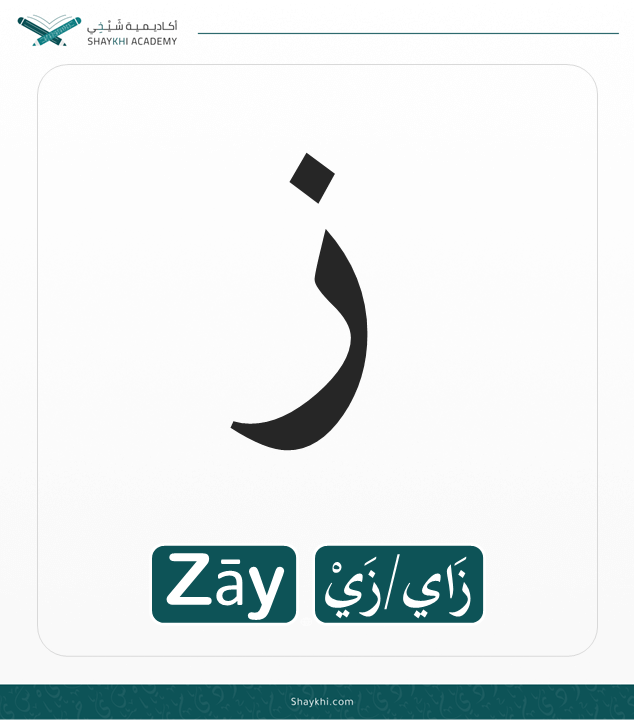
The Point of Articulation of the Letter Zāy (زَاي/زَيْ) is the tongue as the tip of the tongue touches the edge of the front two lower incisors, thus, the sound is produced and passes through the upper and lower incisors.
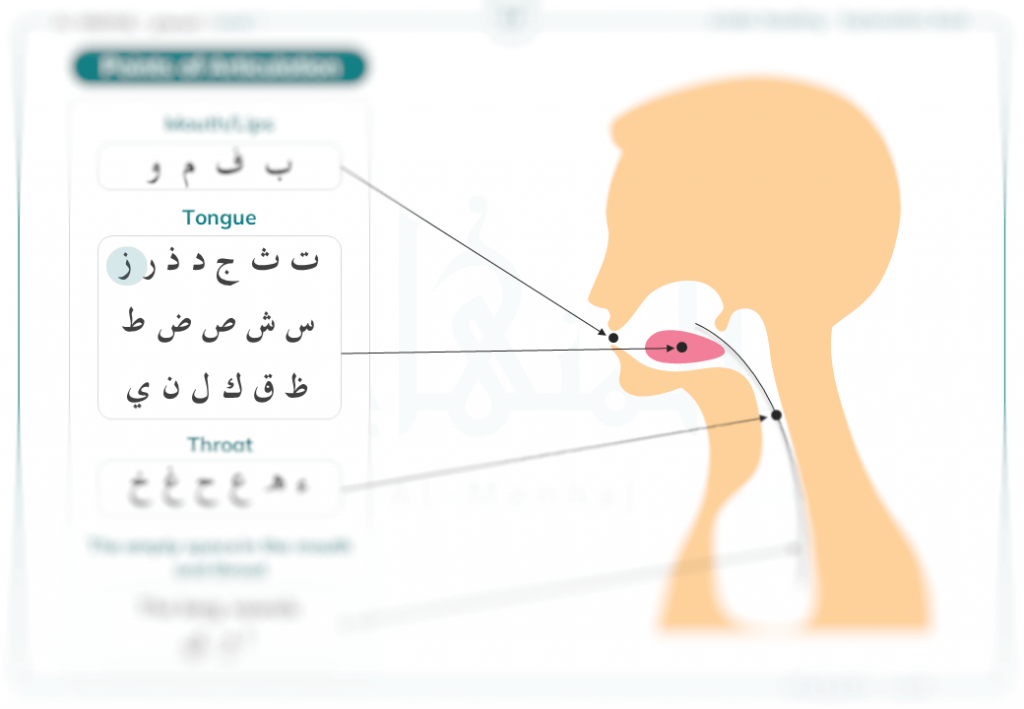
Letter Sīn Pronunciation
Letter Sīn is the 12th letter of Arabic Letters Alphabet Arabic and this’s its shape:
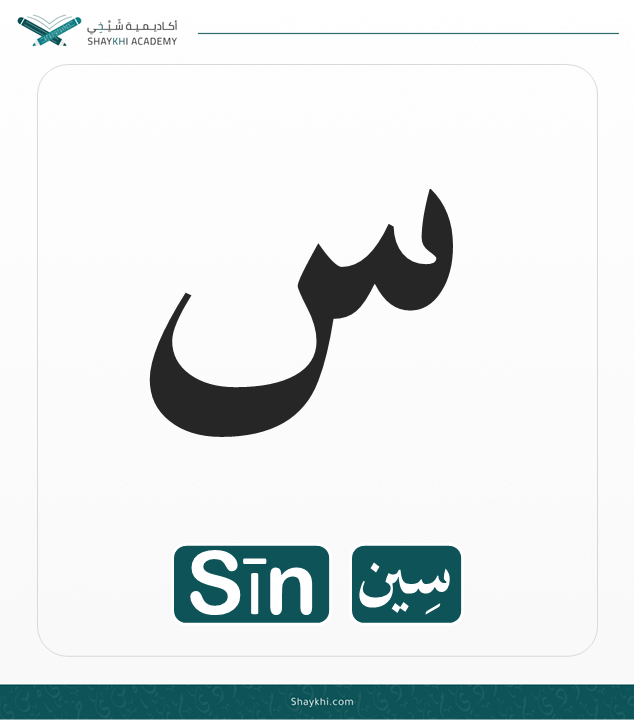
The Point of Articulation of the Letter Sīn (سِيـن) is the tongue as the tip of the tongue touches the edge of the front two lower incisors, thus, the sound is produced and passes through the upper and lower incisors.
To pronounce the letter “seen”, use the tongue on the upper teeth and make the sound.
Its pronunciation is similar to the letter s.
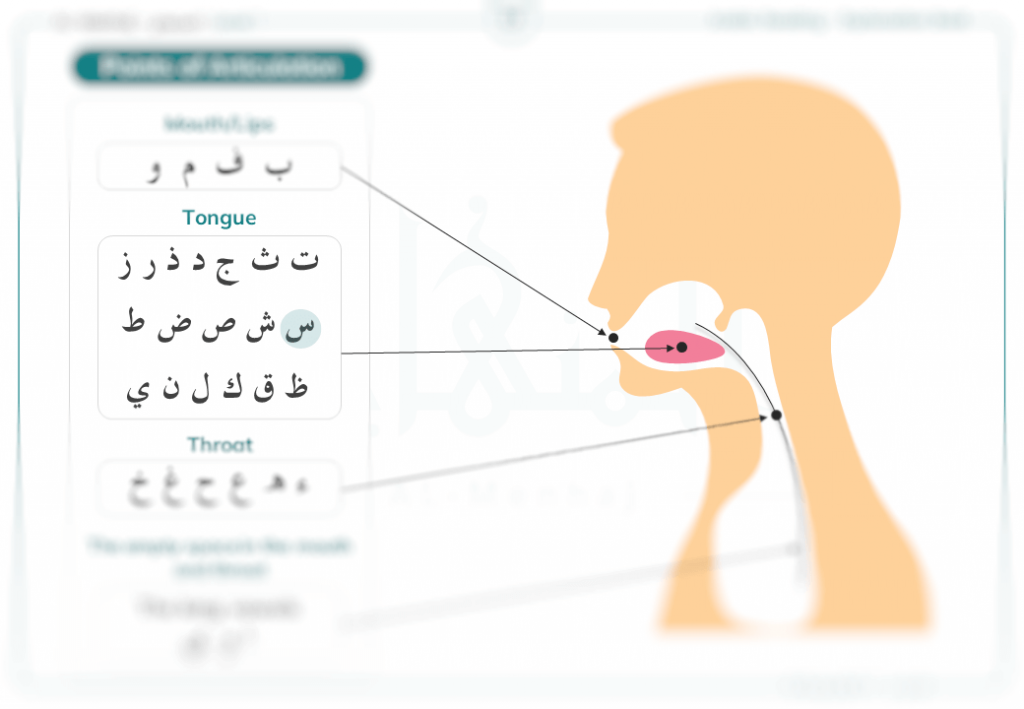
Letter Shīn Pronunciation
Letter Shīn is the 13th letter of Arabic Letters Alphabet Arabic and this’s its shape:
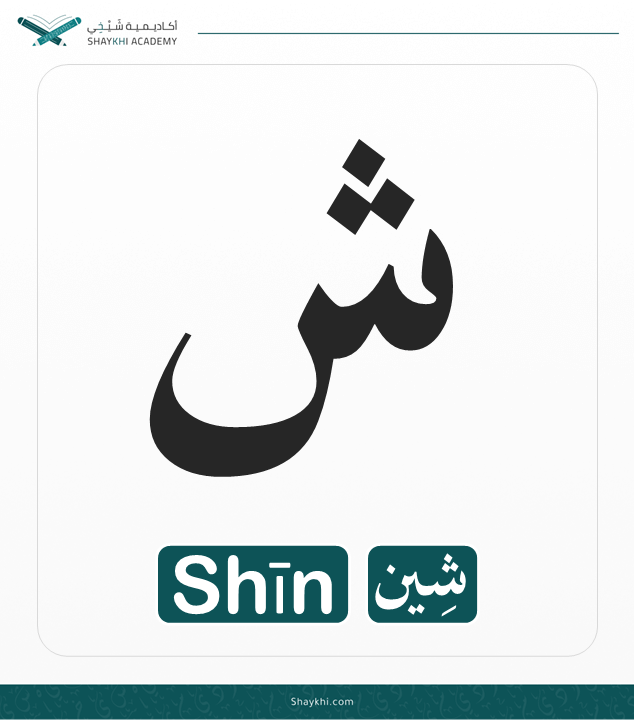
The Point of Articulation of the Letter Shīn (شِيـن) is the tongue as the middle of the tongue touches what lies opposite, which is the roof of the mouth.
Pronounce “sheen” by placing the tongue between the upper and lower teeth and making the sound louder than “s”.
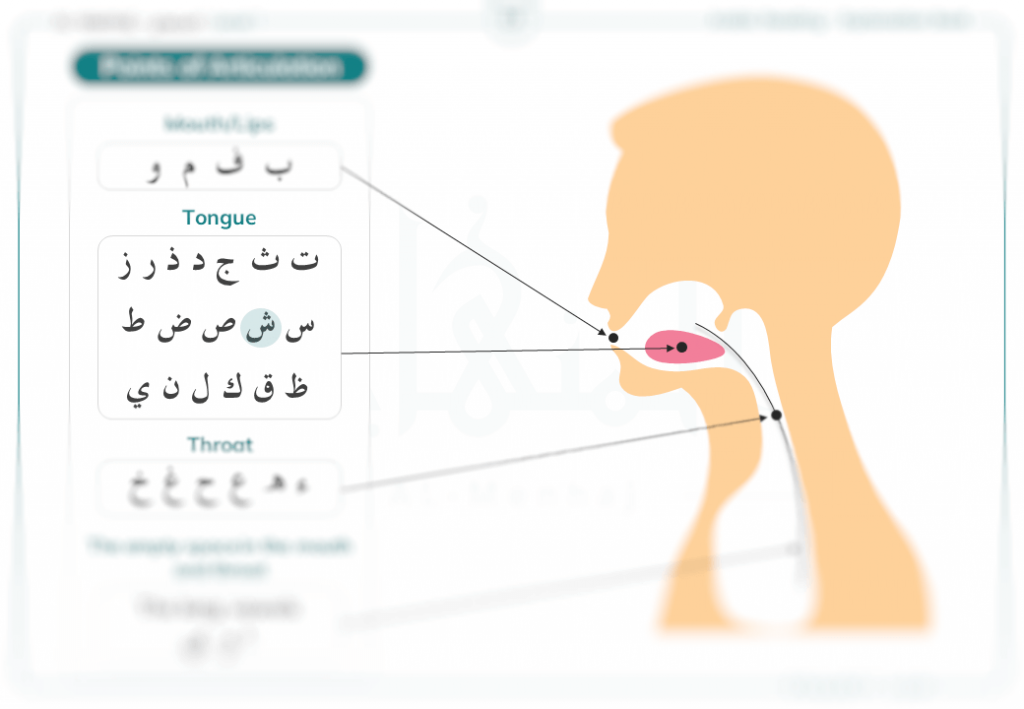
Common mistake: pronouncing the letter Shīn (شِيـن) as a heavy letter when it comes before a heavy letter. An example: شططا
Letter Ṣād Pronunciation
Letter Ṣād is the 14th letter of Arabic Letters Alphabet Arabic and this’s its shape:
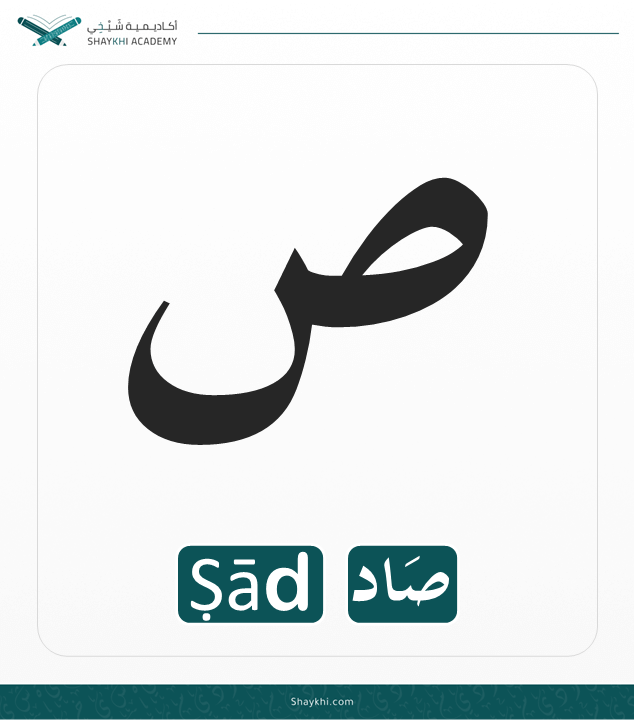
The Point of Articulation of the Letter Ṣād (صَـاد) is the tongue as the tip of the tongue touches the edge of the front two lower incisors, thus, the sound is produced and passes through the upper and lower incisors.
Pronunciation of this letter begins by saying “S” normally and then pulling the middle of your tongue to the base of your mouth, leaving the tip close to your teeth.
You follow this sound with an “a” and end it with a “D”.
The result should be something like SSaad.
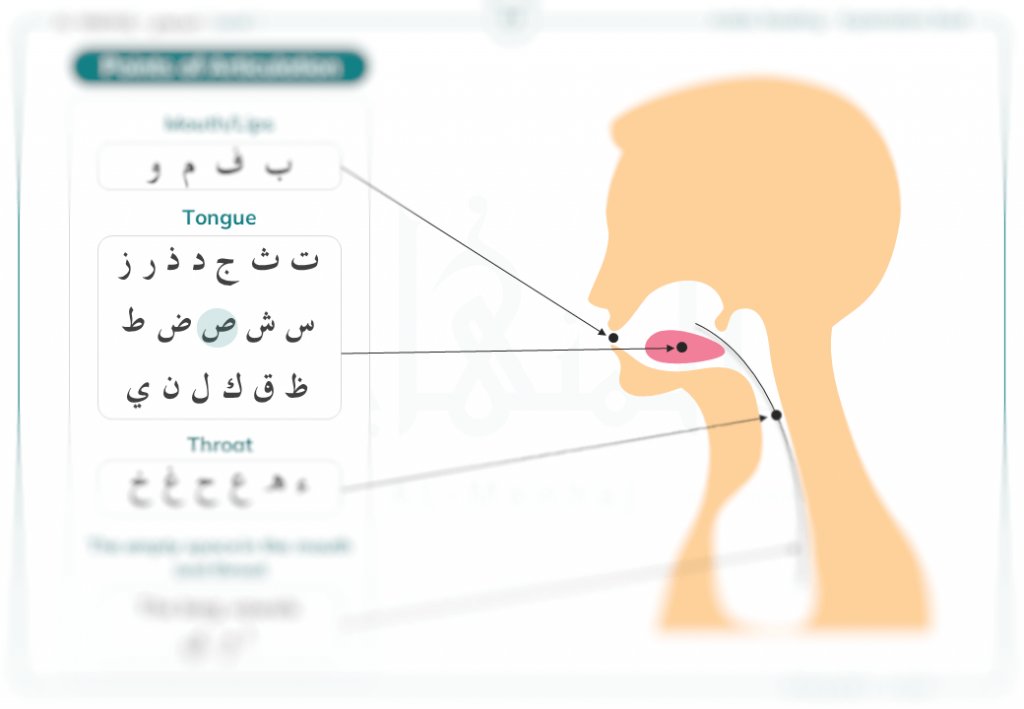
Note: As the letter Ṣād (صَـاد) is a heavy letter, the back of the tongue is raised, and this is what makes the difference between the letter Ṣād (صَـاد) and the letter Sīn (سِيـن), as the tongue is not raised with the latter.
Letter Ḍād Pronunciation
Letter Ḍād is the 15th letter of Arabic Letters Alphabet Arabic and this’s its shape:
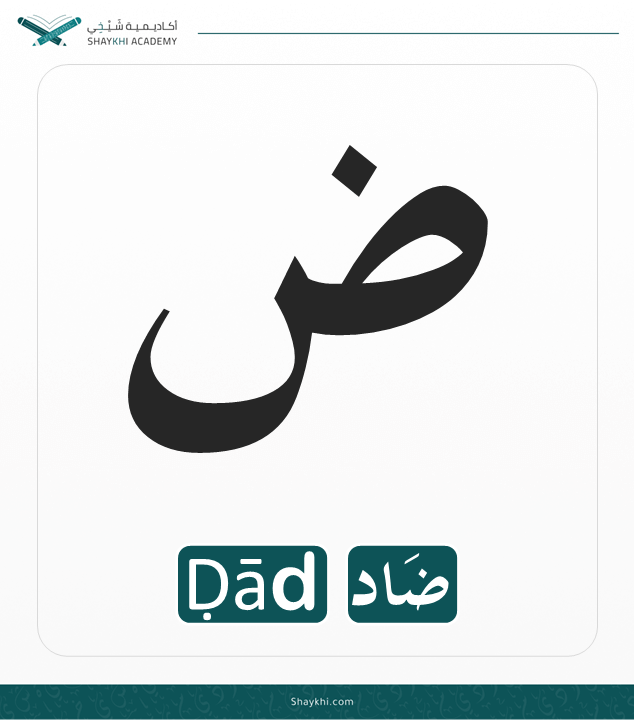
The Point of Articulation of the Letter Ḍād (ضَـاد) is the tongue as one or both back sides of the tongue touches the molars and the gum area next to the molars.
Also like ص, this is a magnified version of د, made by saying D, only pulling the middle of your tongue down. While د is gentle and easy to make, ض or Daad is more of a heavy and deep sound. After pronouncing the sound, open your mouth to add an “aa” sound and end with normal D.
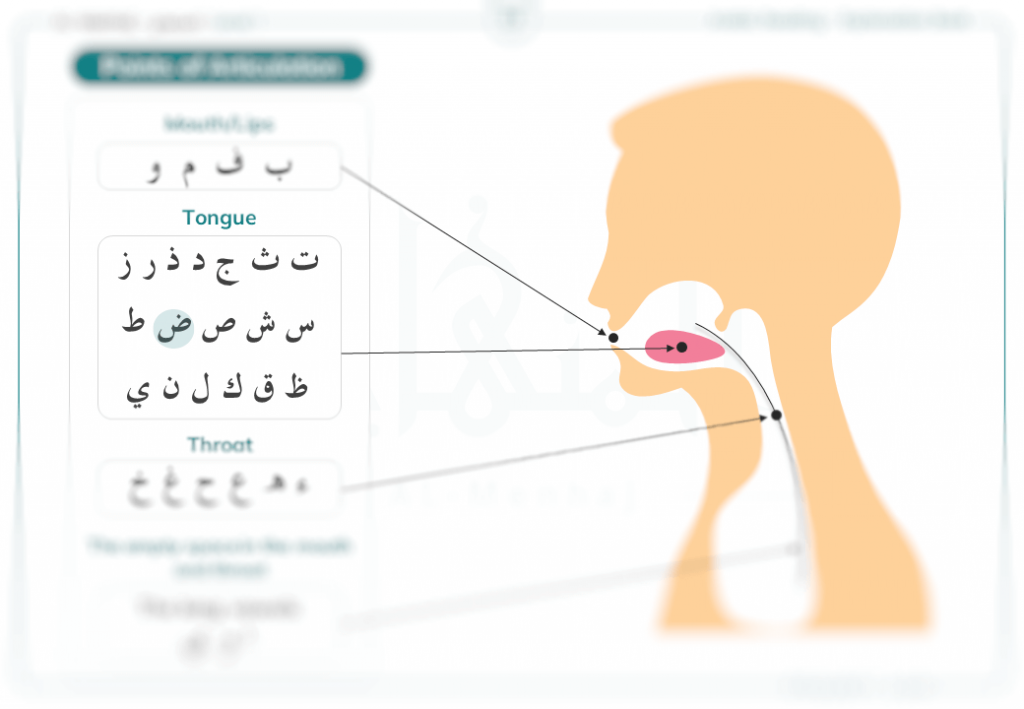
Letter Ṭā’ Pronunciation
Letter Ṭā’ is the 16th letter of Arabic Letters Alphabet Arabic and this’s its shape:
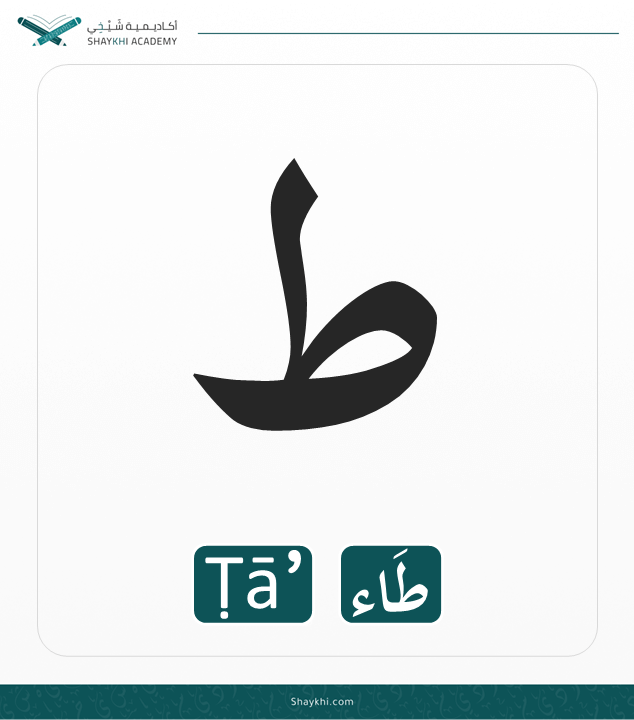
The Point of Articulation of the Letter Ṭā’ (طَـاء) is the tongue as the top side of the tip of the tongue touches the gums of the front two upper incisors.
The sound of this letter is strong. You can pronounce it by placing the tip of your tongue between your teeth, pulling the middle part down, then using air pressure on the teeth and then letting it out forcefully.
We can say that ط is like pressing T.
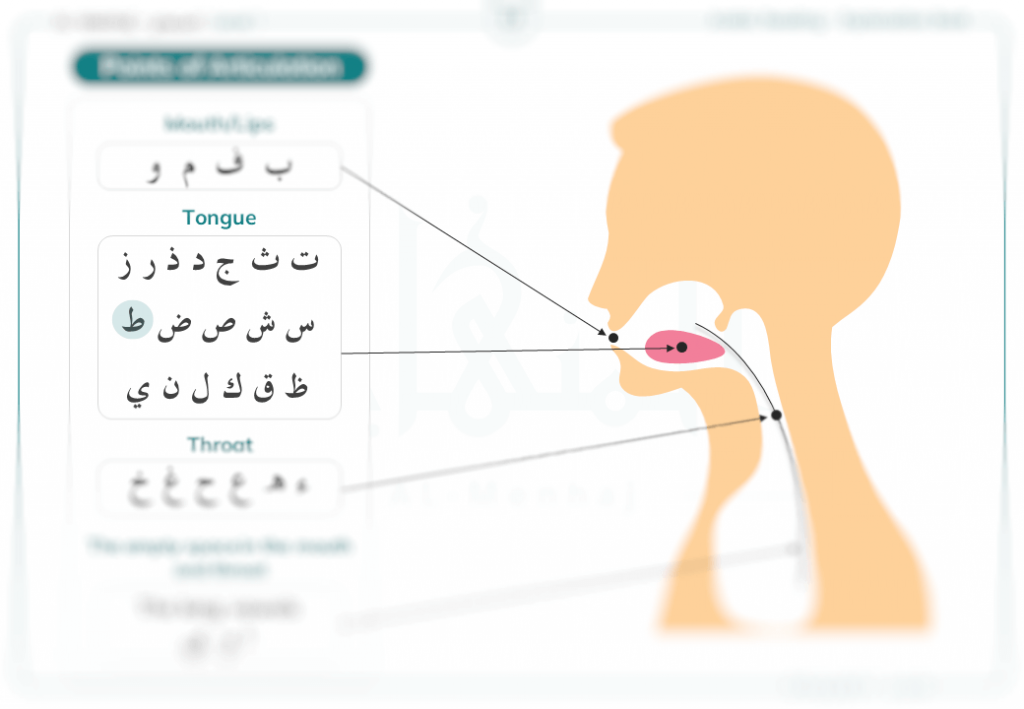
Note: As the letter Ṭā’ (طَـاء) is a heavy letter, the back of the tongue is raised, and this is what makes the difference between the letter Ṭā’ (طَـاء) and the letter Tā’ (تَـــاء) , as the tongue is not raised with the latter.
Common mistake: Making it light. An example: طِباقا.
Letter Ẓā’ Pronunciation
Letter Ẓā’ is the 17th letter of Arabic Letters Alphabet Arabic and this’s its shape:
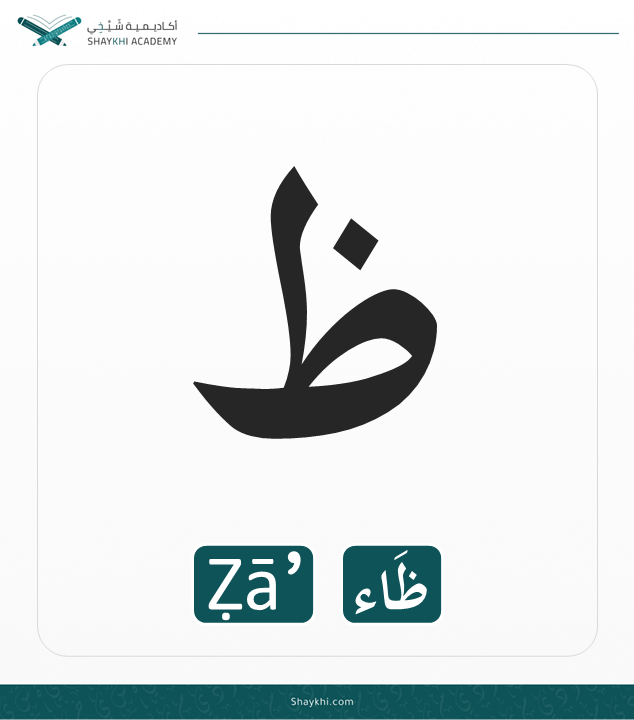
The Point of Articulation of the Letter Ẓā’ (ظَـاء) is the tongue as the tip of the tongue touches the bottom edge of the front two upper incisors.
pronouncing this letter requires pulling the middle part of your tongue downward and ending the exit with an elongated “aaah.”

Note: As the letter Ẓā’ (ظَـاء) is a heavy letter, the back of the tongue is raised, and this is what makes the difference between the letter Ẓā’ (ظَـاء) and the letter Dhāl (ذَال), as the tongue is not raised with the latter.
Letter ‘ayn Pronunciation
Letter ‘ayn is the 18th letter of Arabic Letters Alphabet Arabic and this’s its shape:
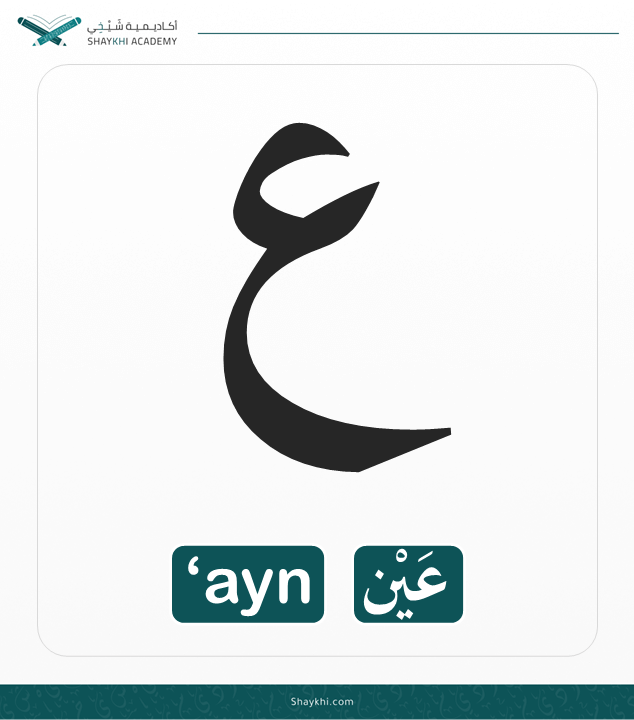
The Point of Articulation of the Letter ‘ayn (عَيْـن) is the throat as it’s pronounced from the middle part of the throat which lies halfway between the beginning and the end of the throat.
You can pronounce the letter Ain by opening the jaws vertically to reach the exit of the Ein and the Haa in the middle of the throat. Then, open the lower lip so that the tips of the teeth appear and the tongue is in the silent position, having no role, and the letter ein comes out of the throat.
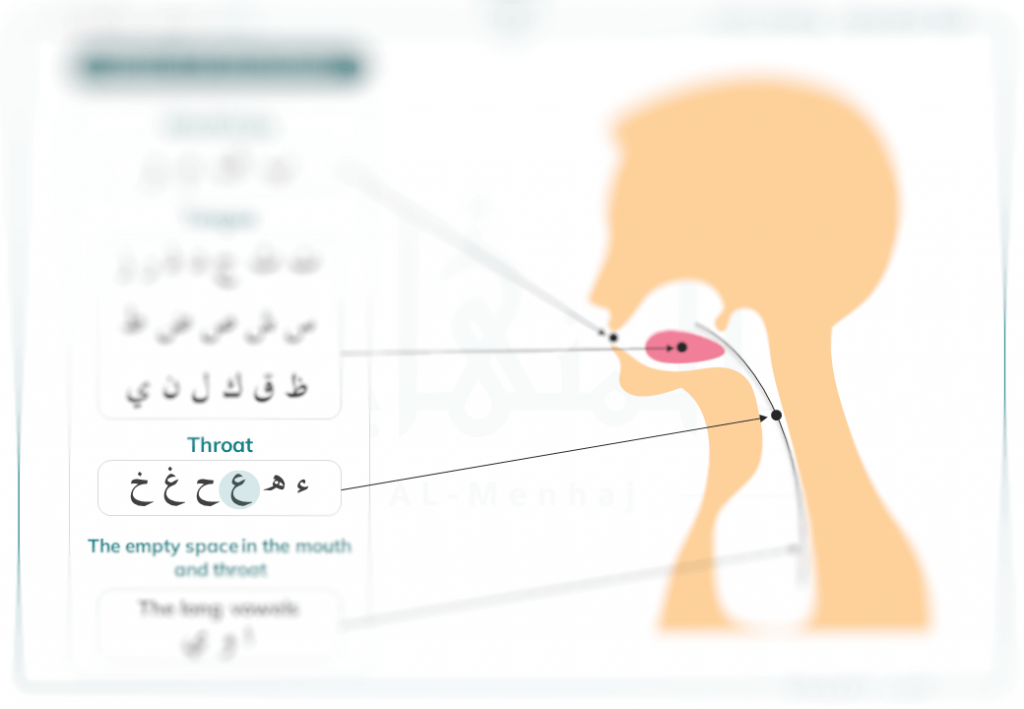
Letter Ghayn Pronunciation
Letter Ghayn is the 19th letter of Arabic Letters Alphabet Arabic and this’s its shape:
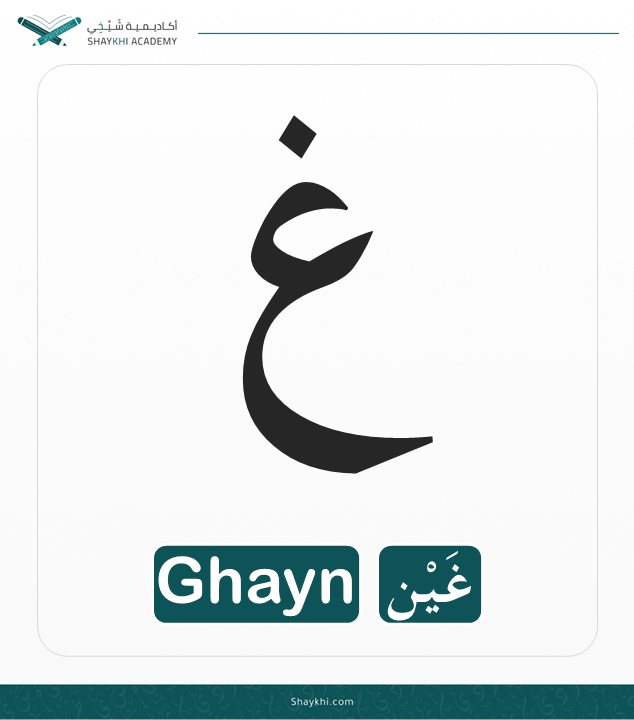
The Point of Articulation of the Letter Ghayn (غَيْـن) is the throat as it’s pronounced from the closest part of the throat which is the beginning of the throat, or the closest to the mouth.
“Gheen” emerges from the bottom of the throat and its sound resembles the sound of gargling water.
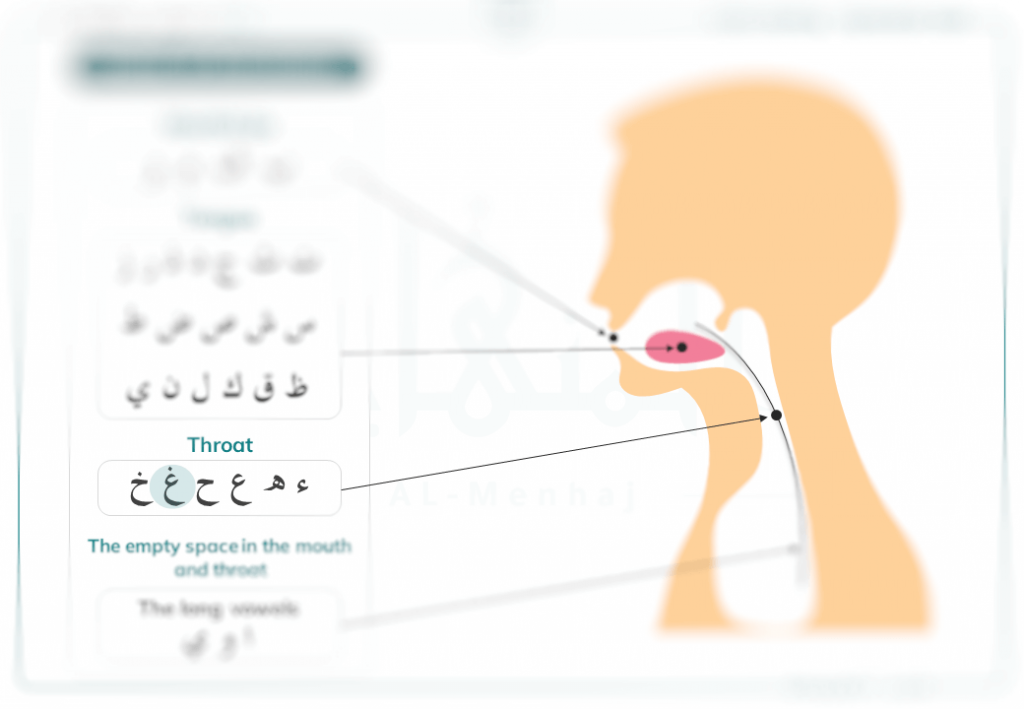
Common mistake: pronouncing the Letter Ghayn (غَيْـن) as Letter Khā’ (خَـاء). An example: يغشى
Letter Fā’ Pronunciation
Letter Fā’ is the 20th letter of Arabic Letters Alphabet Arabic and this’s its shape:
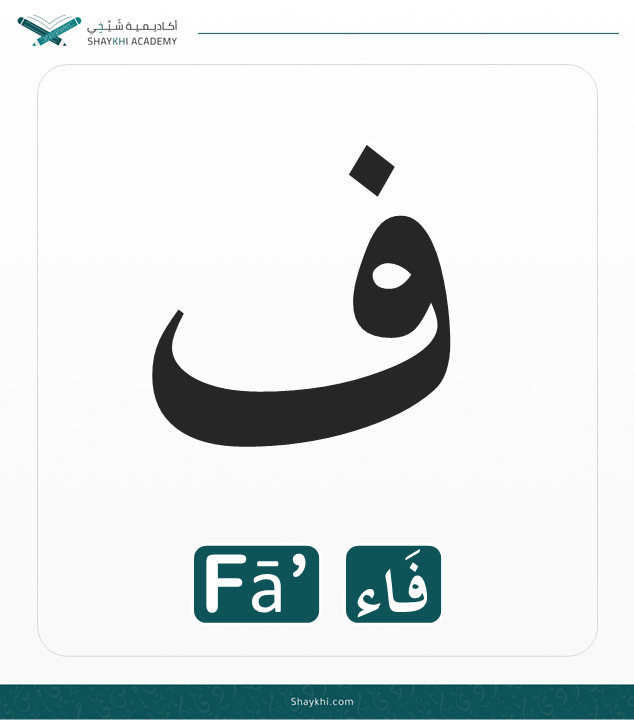
The Point of Articulation of the Letter Fā’ (فَـاء) is the tongue as the bottom edge of the front two upper incisors touches the inner bottom lip.
The letter “faa” is pronounced by placing the upper teeth on the lower lip and forcefully expelling air through the mouth.
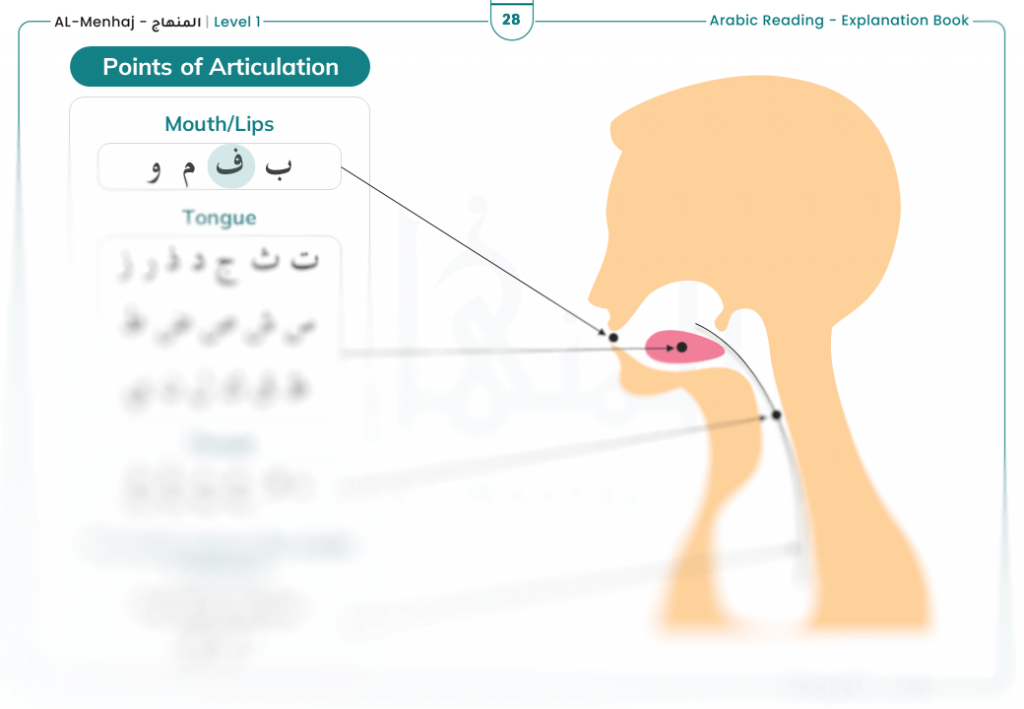
Letter Qāf Pronunciation
Letter Qāf is the 21st letter of Arabic Letters Alphabet Arabic and this’s its shape:
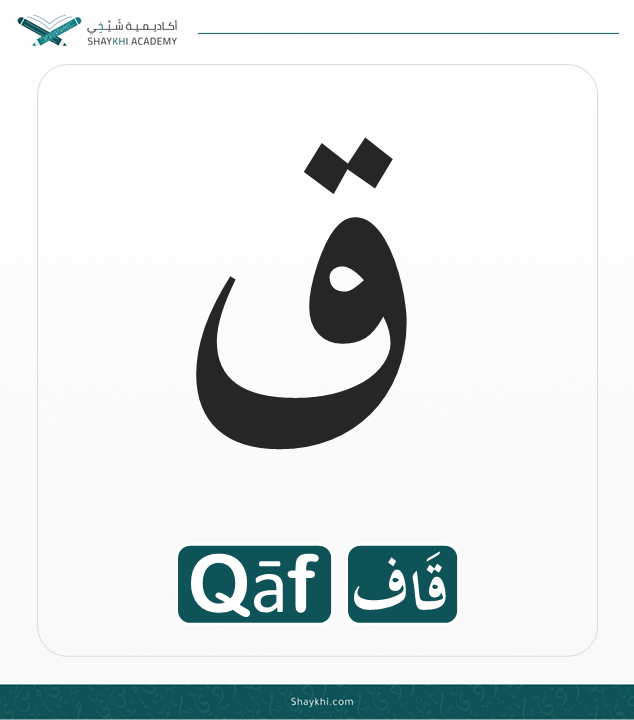
The Point of Articulation of the Letter Qāf (قَـاف) is the tongue as the deepest part of the tongue touches what lies opposite, which is the roof of the mouth (soft palate).
The pronunciation of the letters qaf ق and kaf ك is similar to each other, but while ك is made with pushing your tongue to the roof of your mouth while blocking the air in your throat, this one is made with pulling your tongue down while blocking air. Let the air out from the upper back of your throat. This sound is made in cartoons when a character gulps down a drink.
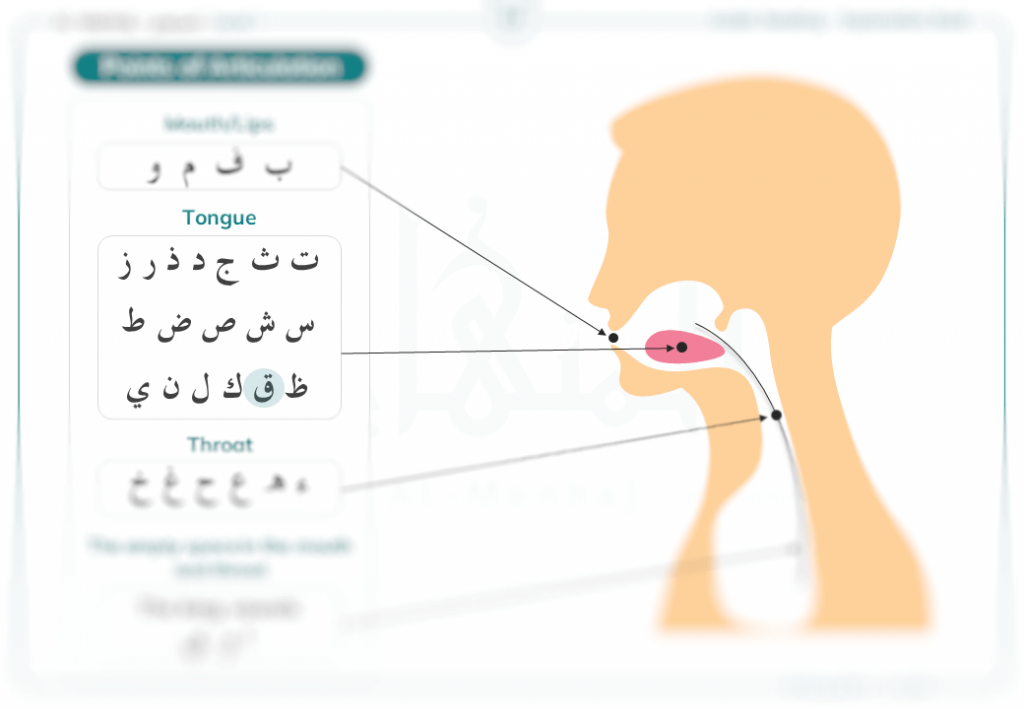
Letter Kāf Pronunciation
Letter Kāf is the 22nd letter of Arabic Letters Alphabet Arabic and this’s its shape:
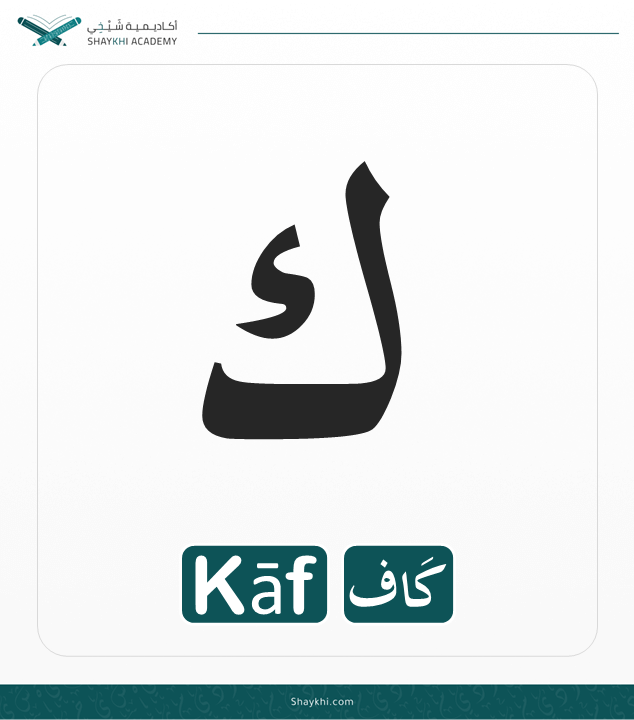
The Point of Articulation of the Letter Kāf (كَـاف) is the tongue as the deepest part of the tongue touches what lies opposite, which is the roof of the mouth (hard palate).
It emerges from the farthest part of the tongue along with the upper palate that is adjacent to it, from both the hard and soft region, slightly below the exit of the qāf, as it is closer to the front of the mouth, and furthest from the throat.
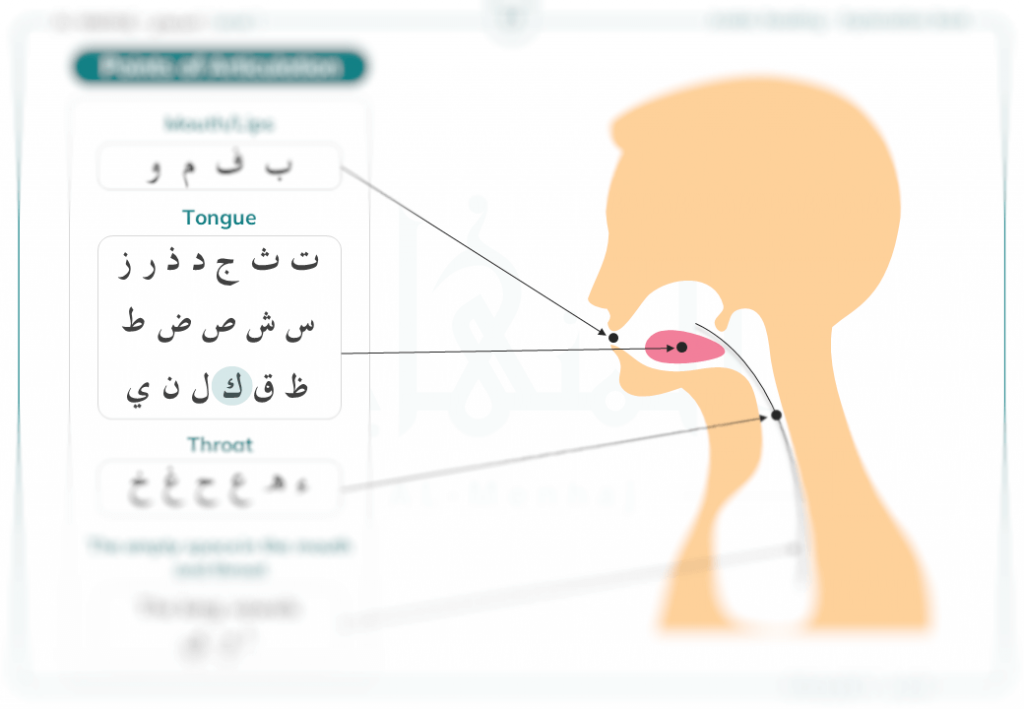
Letter Lām Pronunciation
Letter Lām is the 23rd letter of Arabic Letters Alphabet Arabic and this’s its shape:
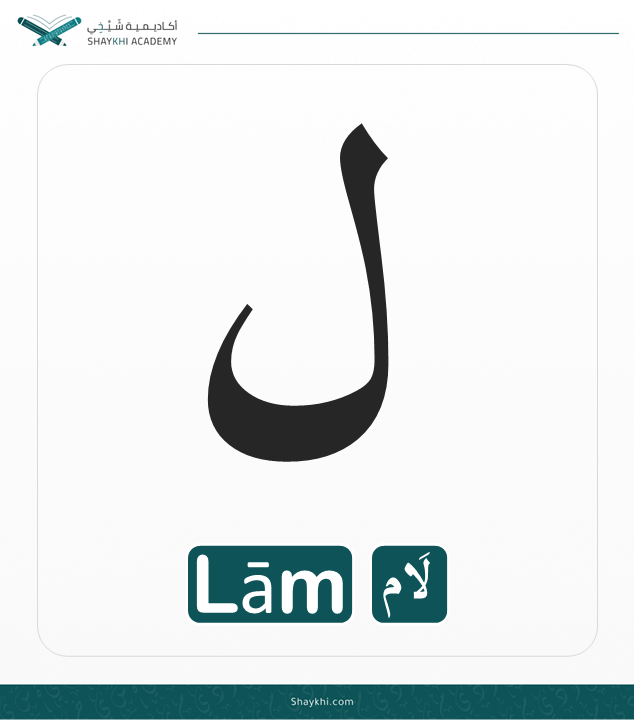
The Point of Articulation of the Letter Lām (لَام) is the tongue as the front side and the tip of the tongue touches what lies opposite to them which are the gums of the two top front incisors, the two top lateral incisors, the two top canines, and the two top premolars.
The lowest edge of the tongue to its end, which is next to the canines, that is, its side from the outside, with the gums of the upper teeth that are adjacent to it.
Its pronunciation is similar to the letter “L”
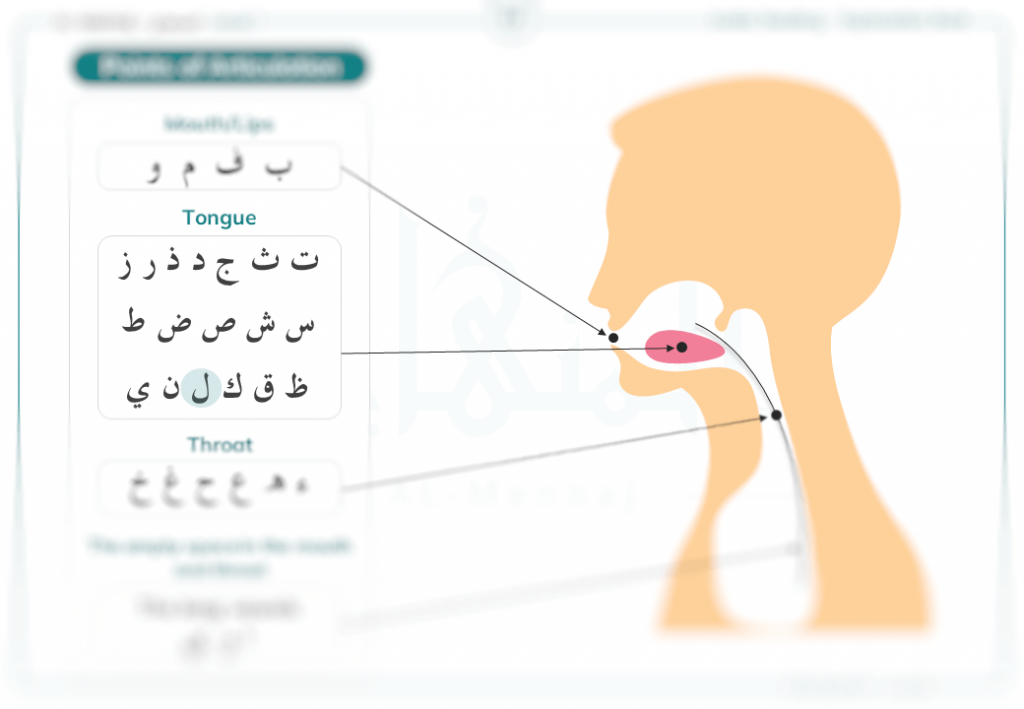
Letter Mīm Pronunciation
Letter Mīm is the 24th letter of Arabic Letters Alphabet Arabic and this’s its shape:
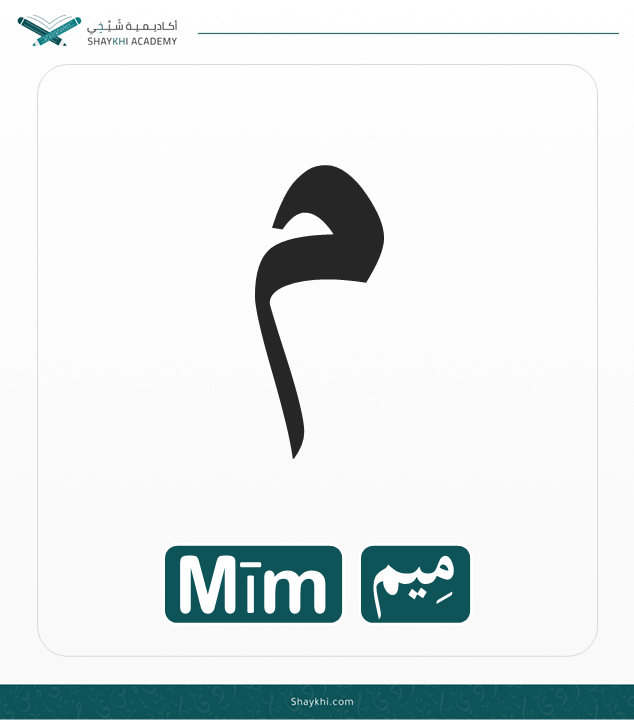
The Point of Articulation of the Letter Mīm (مِـيـم) is the lips as it’s pronounced by closing or pressing the two lips together.
The letter Meem is produced by clenching the upper lip to the lower lip from the outside.
When pronouncing it, even if the tongue does not have a significant role, it falls completely at the bottom of the mouth and does not attach to the upper palate.
Its pronunciation is similar to the letter “M”
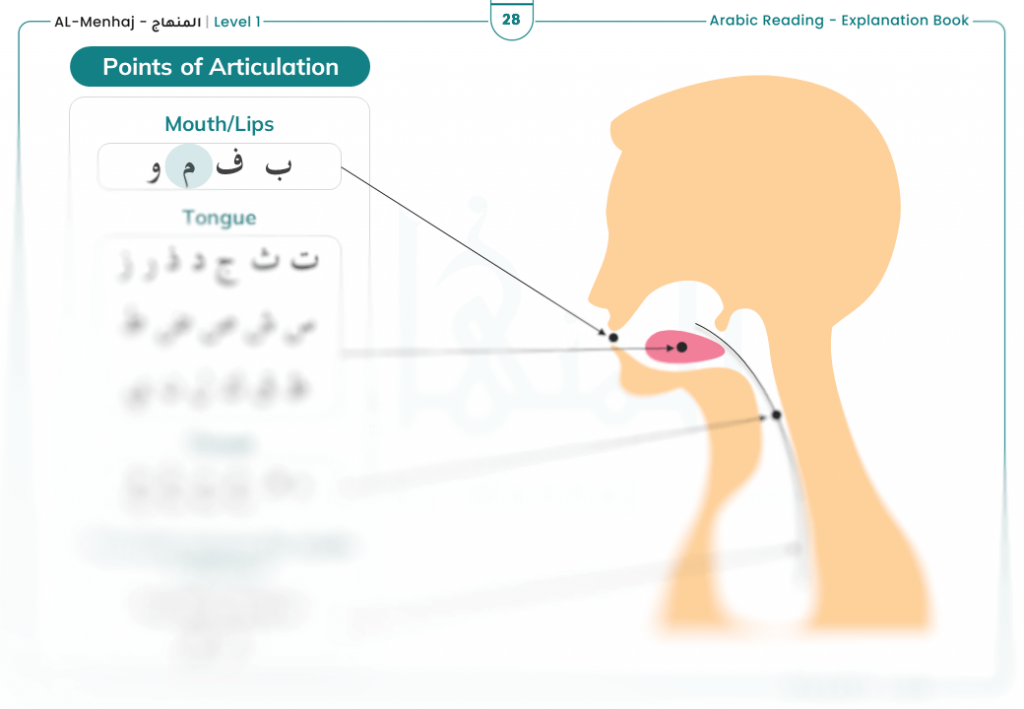
Note: When pronouncing the letter Mīm (مِـيـم), part of the sound comes from the mouth whilst the other part comes from the nose.
Letter Nūn Pronunciation
Letter Nūn is the 25th letter of Arabic Letters Alphabet Arabic and this’s its shape:

The Point of Articulation of the Letter Nūn (نُـون) is the tongue as the tip of the tongue touches the gums of the front two upper incisors.
The exit of the letter Noon is from the delicate tip of the tongue along with the origins of the two upper folds that align with it, below the exit of the laam.
Note that the lam is closer to the outside, followed by the nun towards the inside, towards the throat.
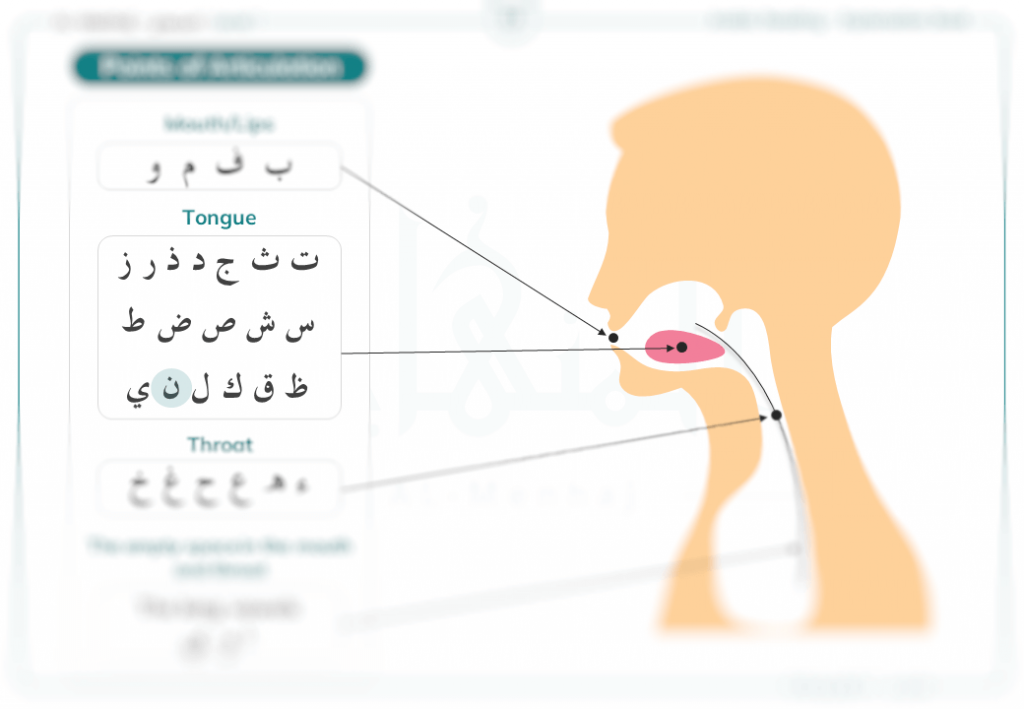
Note: the Letter Nūn (نُـون) is pronounced slightly behind the gums (towards the upper palate) in comparison to the articulation point of the Letter Lām (لَام). Also, a part of the sound comes from the mouth whilst the other part comes from the nose!
Letter Hā’ Pronunciation
Letter Hā’ is the 26th letter of Arabic Letters Alphabet Arabic and this’s its shape:
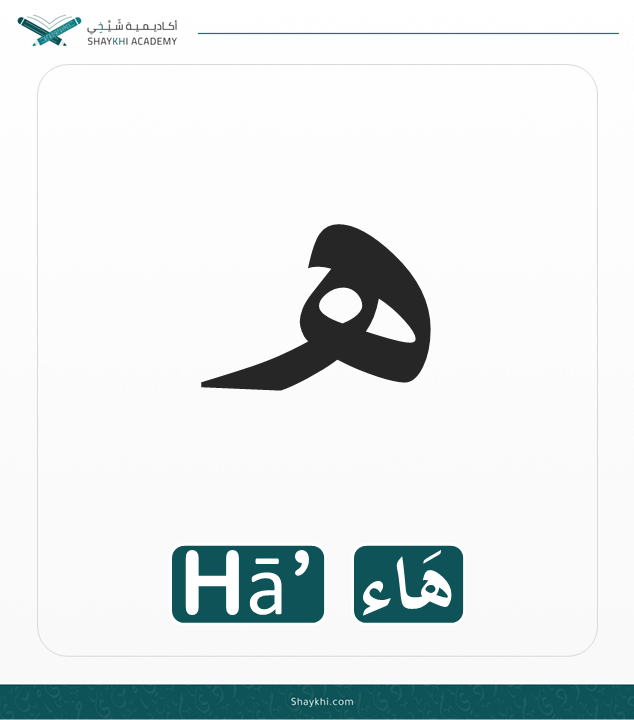
The Point of Articulation of the Letter Hā’ (هَـاء) is the throat as it’s pronounced from the deepest part of the throat which is the furthest away from the mouth and the closest to the chest.
The exit of the letter “H” is approximately the same as the exit of the letter “Haa هــ” but it may approach the letter “ح” in a slight approach that may not be apparent to many listeners.
In order to pronounce the letter Haa, you must press it because it is one of the soft, whispered throat letters, and they are two characteristics of weakness. Moussa means there is a flow and flow in the breath, and soft means it is accompanied by a flow in the sound.

Common mistake: making it heavy. An example: النَّهار
Letter Wāw Pronunciation
Letter Wāw is the 27th letter of Arabic Letters Alphabet Arabic and this’s its shape:
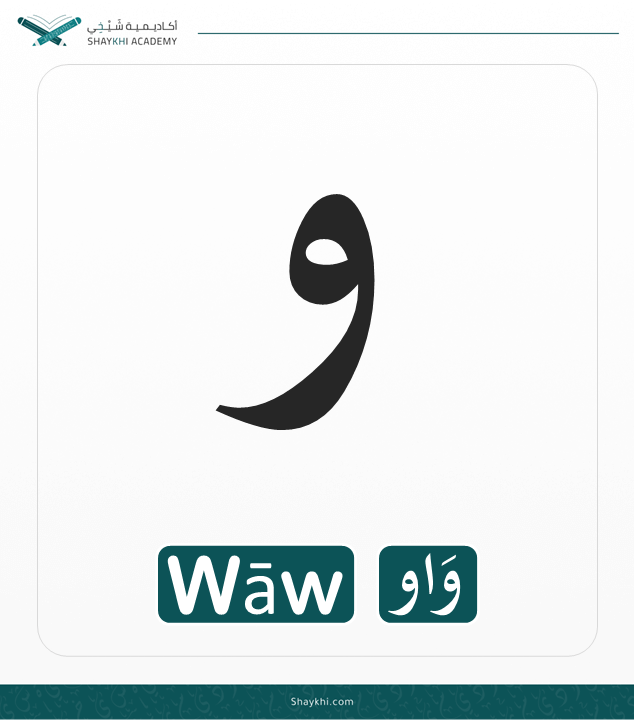
The Point of Articulation of the Letter Wāw (وَاو) is the lips as it’s pronounced by circling the two lips without meeting completely.
To pronounce the letter waw, you must press your lips together and then the sound comes out by opening them.
Like saying waaw.
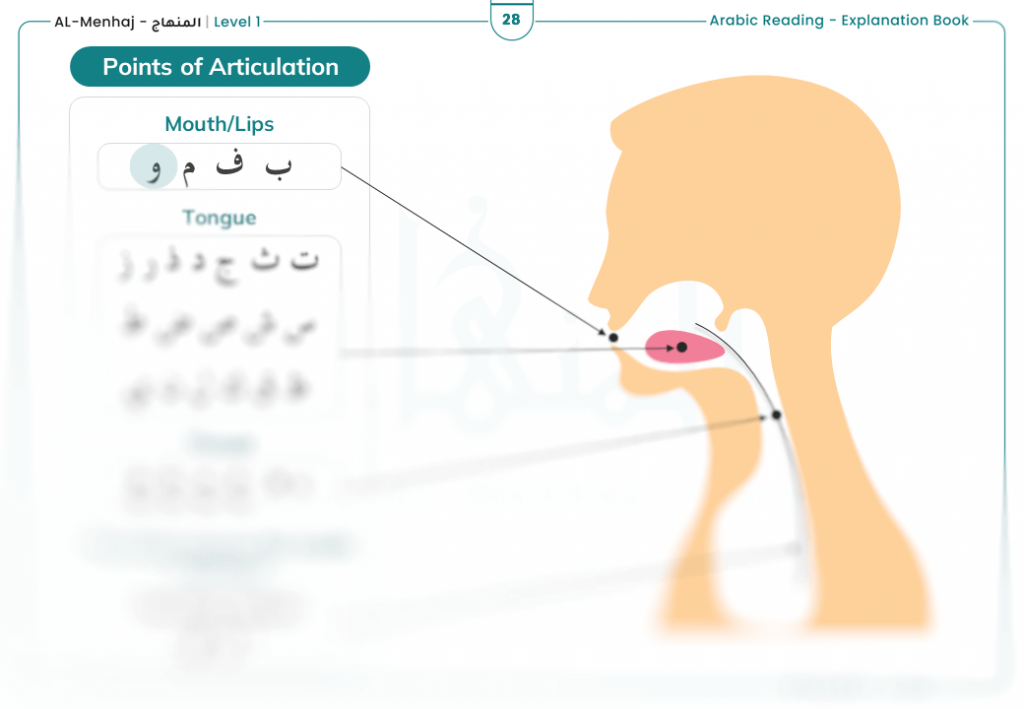
Common mistake: pronouncing the Letter Wāw heavy when followed by a heavy letter. Example: وَاللَّهُ.
Letter Hamza Pronunciation
Letter Hamza is the 28th letter of Arabic Letters Alphabet Arabic and this’s its shape:
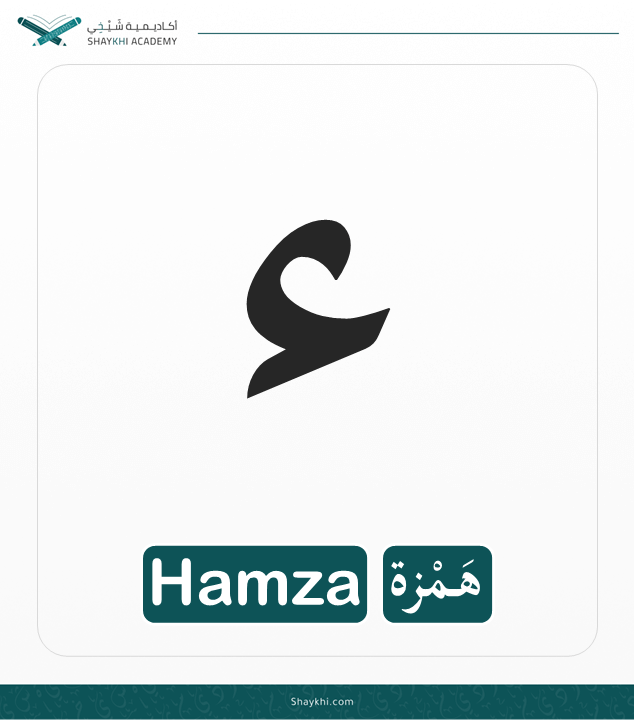
The Point of Articulation of the Letter Hamza (هَــمْـزَة) is the throat as it’s pronounced from the deepest part of the throat which is the furthest away from the mouth and the closest to the chest.
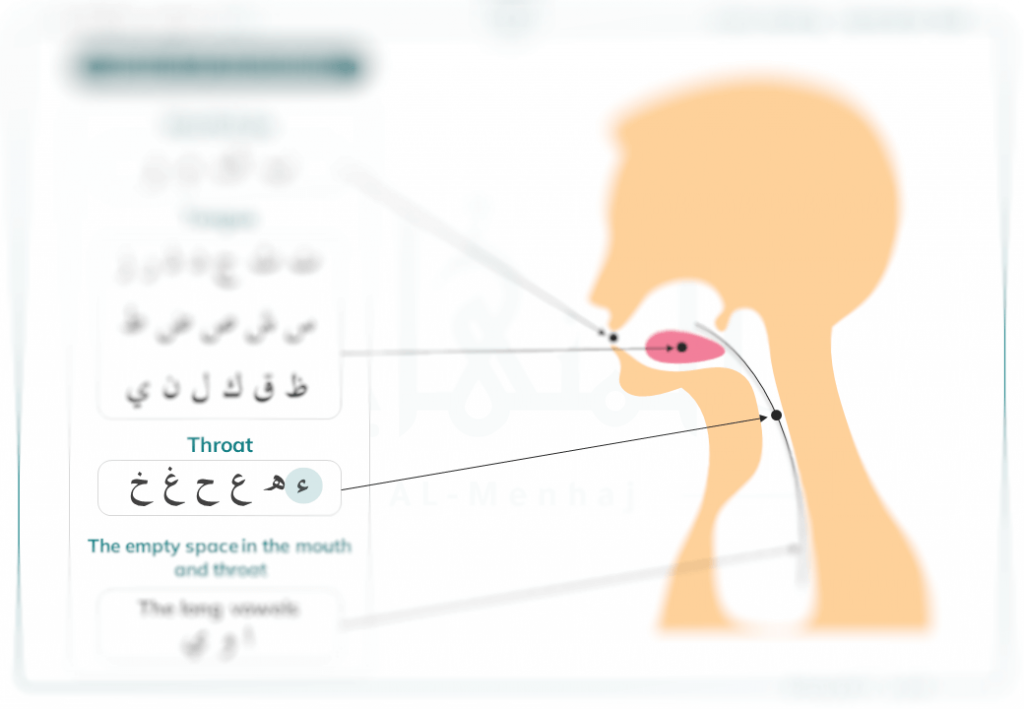
Letter Yā’ Pronunciation
Letter Yā’ is the 29th letter of Arabic Letters Alphabet Arabic and this’s its shape:
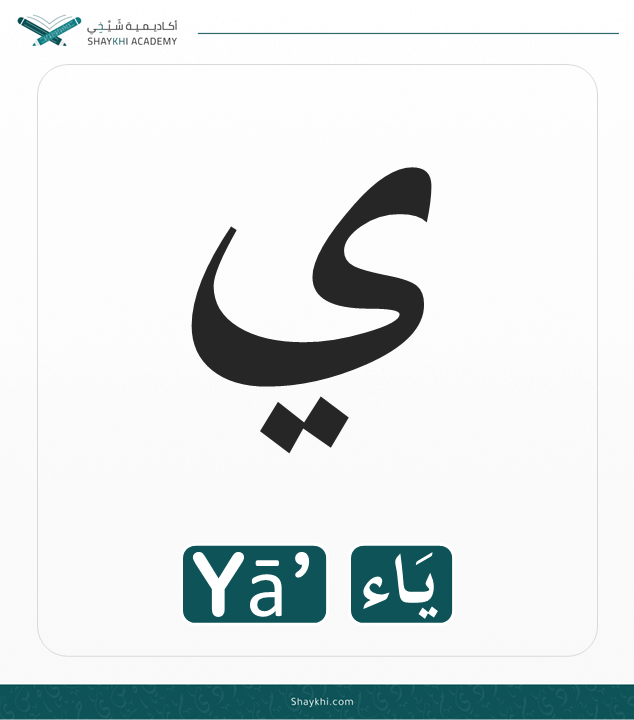
The Point of Articulation of the Letter Yā’ (يَـاء) is the tongue as the middle of the tongue touches what lies opposite, which is the roof of the mouth.
The letter Ya emerges from the middle of the tongue aligning with the upper palate.
As for the rest of the letters, they are called trickier letters, which are “ح- خ- -ص
ض- ط- ظ- ع- ز- ق”
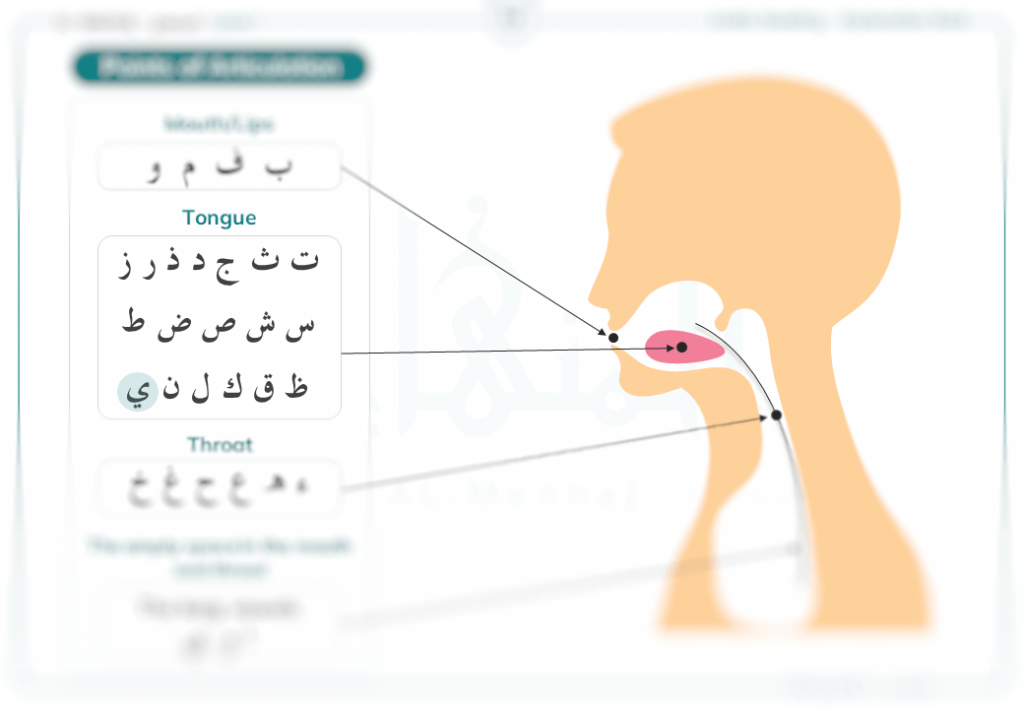
If you want to learn Arabic Reading, its letters, and the points of articulation, you can join our online classes, and here is an example of our online classes!
Names of Arabic Letters’ Table
In the next table, we will show you the Names of all Arabic Letters in English and arabic letters translation with the shape of the letter.
| Letter’s Number | Letter’s Shape | Letter’s Name |
|---|---|---|
| 1 | ا | the letter Alif (ألف) |
| 2 | ب | the letter Bā’ (بَـــاء) |
| 3 | ت | the letter Tā’ (تَـــاء) |
| 4 | ث | the letter Thā’ (ثَـــاء) |
| 5 | ج | the letter Jīm (جِـيـم) |
| 6 | ح | the letter Ḥā’ (حَـاء) |
| 7 | خ | the letter Khā’ (خَـاء) |
| 8 | د | the letter Dāl (دَال) |
| 9 | ذ | the letter Dhāl (ذَال) |
| 10 | ر | the letter Rā’ (رَاء) |
| 11 | ز | the letter Zāy (زَاي/زَيْ) |
| 12 | س | the letter Sīn (سِيـن) |
| 13 | ش | the letter Shīn (شِيـن) |
| 14 | ص | the letter Ṣād (صَـاد) |
| 15 | ض | the letter Ḍād (ضَـاد) |
| 16 | ط | the letter Ṭā’ (طَـاء) |
| 17 | ظ | the letter Ẓā’ (ظَـاء) |
| 18 | ع | the letter ‘ayn (عَيْـن) |
| 19 | غ | the letter Ghayn (غَيْـن) |
| 20 | ف | the letter Fā’ (فَـاء) |
| 21 | ق | the letter Qāf (قَـاف) |
| 22 | ك | the letter Kāf (كَـاف) |
| 23 | ل | the letter Lām (لَام) |
| 24 | م | the letter Mīm (مِـيـم) |
| 25 | ن | the letter Nūn (نُـون) |
| 26 | هـ | the letter Hā’ (هَـاء) |
| 27 | و | the letter Wāw (وَاو) |
| 28 | ء | the letter Hamza (هَــمْـزَة) |
| 29 | ي | the letter Yā’ (يَـاء) |
Arabic Alphabet PDF
As for the rest of the letters, they are called trickier letters, which are “ح- خ- -ص
ض- ط- ظ- ع- ز- ق”
Arabic alphabet phonetic
Phonetics in general, or phonology, is a new and old science, new because it is one of the branches of linguistics that was founded at the beginning of the twentieth century, and old because it is one of the sciences on which every language is based. Language is the sounds of which words are composed, which are organized into sentences and give various meanings.
Phonology is concerned with the study of human sounds in terms of the way they are pronounced, the speech organs responsible for their production, and their vocal characteristics. In the Hebrew language, each sound (letter) has a set of characteristics that distinguish it from other sounds. The B sound, for example, is:
1- A bilateral oral sound: because the two lips participated together in producing it, and it was not produced from one lip.
2- Explosive: That is, the air was trapped and accumulated in the oral cavity before pronouncing it, and then came out all at once when pronouncing it.
3- Passive: That is, the two vocal strings vibrate when pronouncing it.
This is the case with the rest of the letters. The phonemes in the Arabic language are as diverse as the letters.
Arabic alphabet and pronunciation
The pronunciation of Arabic letters varies depending on the movement or formation of the letter, depending on the position of the word that contains the letter in the sentence
An example of this is the letter b ب in the word بِئر is different from the letter b ب in the word بَاب, which is different from the letter bب in the word بٌور.
In the first, we pronounce the “ba” with kasra, while in the second, we pronounce it with fatha, and in the third, we pronounce it with dhamma.
Arabic alphabet with English pronunciation
Most Arabic letters have an equivalent sound in the English language, such as (sس – H هـ – أ A) and many others, but there are some letters that do not have a direct equivalent sound in the English language, which may represent a challenge for English speakers. One example of this is the letter (daad ض), a letter widely used in Arabic that does not exist in other languages. Thanks to this famous letter, the Arabic language is sometimes called “the language of daad.
How to pronounce the Arabic alphabet?
Pronunciation in the Arabic language is somewhat difficult due to the difference in pronunciation of the letter according to its diacritics, as we mentioned, but in order to pronounce the Arabic letters correctly, you must memorize the outline of the sound of each letter and memorize its shape well, then try to pronounce each letter out loud several times in the method we mentioned above. Pronounce each letter, take your time, and do it slowly.
Arabic Alphabet and Sounds
Linguists have classified the sounds in the Arabic language into two main categories.
- Silent Sounds
Which are letters that are pronounced without making a sound. Scientists focused their studies on the origins of these sounds and their characteristics.
- Consonant Sounds
Which are the basic movements in the Arabic language.
Consonant sounds in the Arabic language are classified into six types: (the fatha, the damma, the kasra, the extended alif, the extended waw, and the extended yaa.
The sound system in each language is the basis on which learners understand it. The speech process includes five successive stages, starting with the psychological and mental processes of the speaker, then moving on to the production of sounds produced by the speech system.
It must be known that sounds in the Arabic language are characterized by several characteristics, such as intensity, softness, and mediation, as well as qalqalah, loudness, and whispering, as well as amplification and thinning, and solar and lunar.
Learn Arabic Alphabet Pronunciation
Learning to pronounce the Arabic letters is not difficult for non-native speakers, especially since many of the letters are similar in pronunciation to the pronunciation of the English letters.You can learn Arabic phonetics and pronounce the letters of the Arabic alphabet easily and quickly through the online Arabic alphabet pronunciation classes provided by Shaykhi Academy at the hands of a number of specialized teachers with experience in this field and they have the strong advantage that they are teachers of Arabic origin and therefore you will get the language from its correct source. You can visit shaykhi academy and book your first trial class now.
Makharij Arabic Alphabet
Makharij al huroof are the places from which the letter emerges, i.e. the place where the sound emerges, and the place where the letter emerges linguistically and basically. It also includes the place where the letter is getting when pronouncing it and distinguishing it from other letters.
The number of points for pronouncing letters has been the subject of debate among scholars. According to some, the words are fourteen, including Al-Qatrab, Al-Jami’, and Al-Far. While Al-Jazari and Al-Khalil bin Ahmed scored 17 points. Others, such as Sibawayh and Al-Shatibi, thought it was sixteen, and the majority of scholars agreed with them.
We can pronounce the letter silently to determine the exit of the letter, or we can only pronounce it reinforced after the hamza (ء) with a fatha, kasra, or dhamma and determine the exit of the letter by noting the location of the sound. Cutting occurs. This method is the simplest way to determine the exits of letters without having to study them in depth.
How to Know The Point of Articluation (Makhraj) of Any Arabic Letter?
Put the letter you want to know its point of articluation or Makhraj in the state of Al-Sukon, then put the letter Hamza (هَــمْـزَة) before it, and lastly, pronounce it! If you want, for example, to know the point of articulation of the letter Fā’ (فَـاء), you’ll apply the rule to pronounce (أَفْ).
For more information about letters’ points of articulation, kindly check this article!
Unlock the Path to Quranic Mastery with Shaykhi Academy!
Are you seeking the finest Quranic education right from the comfort of your home? Look no further! Shaykhi Academy stands out as a premier online Quran learning platform, dedicated to providing exemplary education to both children and adults.
Why Choose Shaykhi Academy?
- Connect with highly qualified native tutors.
- Flexible scheduling to suit your busy lifestyle.
- Affordable classes tailored for all levels.
- Accessible from anywhere around the globe.
Discover Our Range of Courses:
- Arabic Noorani Qaida: Lay a solid foundation for Quranic studies.
- Online Quran Classes for Kids: Engaging lessons for lifelong learning.
- Tajweed Rules for Kids: Learn to recite with confidence.
- Quran Hifz for Kids: Step-by-step guidance to memorize the Quran.
- Quran for Adults: Introduce yourself to Quran reading and Tajweed rules.
- Online Arabic Courses: Master the language of the Quran.
- Islamic Studies: A wide range of topics related to Islam, including theology, law, Quranic studies, Hadith.
Don’t Miss Out on Your Chance to Excel!
Whether you’re a beginner or seeking advanced knowledge, Shaykhi Academy can guide you! Book your free trial now and make Ramadan 2024 your Quranic turning point!

Conclusion:
Mastering the pronunciation of the Arabic alphabet is fundamental for understanding and speaking the language fluently. The distinct sounds and articulations of each letter, along with their phonetic characteristics, require focused learning and practice. Resources like online courses can aid learners in grasping the intricacies of Arabic pronunciation. By understanding the makharij al huroof and embracing the diversity of Arabic sounds, learners can navigate the complexities of the language with confidence and precision.
